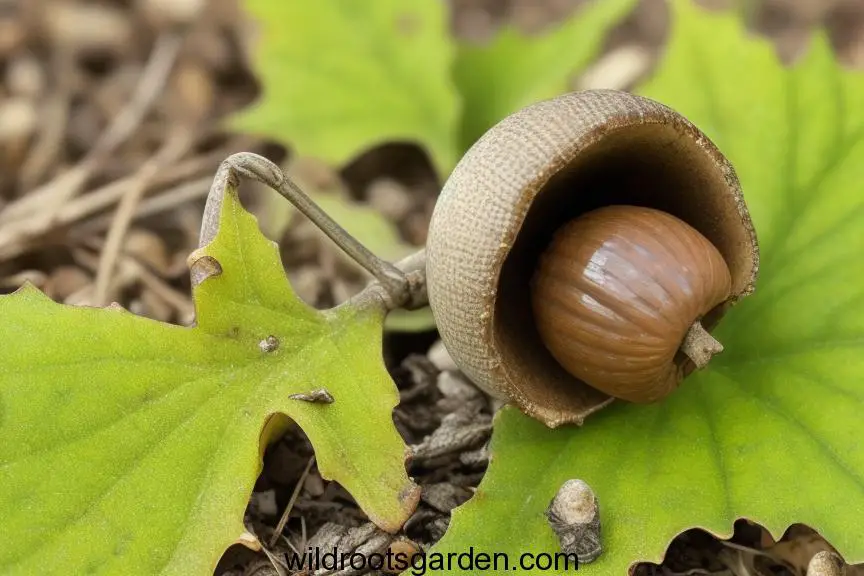A Comprehensive Guide to Identifying Acorn. Identifying different species of acorns involves observing various characteristics. Start by examining the size, shape, and color of the acorn itself, noting any variations in these traits. Pay attention to the cap, or cupule, that covers the acorn’s base – differences in size, texture, and attachment can provide crucial clues. Additionally, study the acorn’s stem and its attachment point on the capsule; these features can vary significantly between species. Analyze the overall texture of the acorn’s shell—is it smooth or rough? Some species have distinctive patterns or markings. Finally, consider the habitat where you found the acorn, as different species tend to thrive in specific environments. Combining these observations can help differentiate between various acorn species, but precise identification may require more specialized botanical expertise or resources.
Length
Observe the size of the acorn. Compare it to known measurements for red and white oak groups. Generally, white oak acorns are smaller, usually measuring around 1 inch in length, while red oak acorns tend to be larger, often exceeding 1 inch.
Cups (Cupules)
Examine the cupule at the base of the acorn. Note its texture and shape. In the white oak group, cupules are smoother, resembling saucers. On the other hand, red oak cupules are typically more spiky or fringed in appearance.
Color
Take note of the acorn’s color. White oak acorns usually have a paler, light brown color, while red oak acorns exhibit a darker and more vibrant hue, often leaning towards a deeper brown shade.
Shape
Analyze the overall shape of the acorn. White oak acorns are generally rounder and more symmetrical, resembling a classic acorn shape. In contrast, red oak acorns often have an elongated or oval shape.
Red and White Oak Groups
Consider the context of the acorn within the broader classification of red and white oak groups. White oak acorns tend to possess characteristics like smaller size, smoother cupules, paler color, and a rounder shape. Red oak acorns, on the other hand, are typically larger, have spikier cupules, a darker color, and a more elongated shape.
By following these steps and comparing your observations to the known traits of the red and white oak groups as outlined in the article, you can more accurately identify different acorn species and distinguish between these two major categories.
identifying common acorn species with characteristics
Acorns are nut-like fruits produced by oak trees. While I can’t provide real-time or the most up-to-date information, I can certainly describe some general characteristics that might help you identify different species of acorns.
The acorns of the Coast Live Oak (Quercus agrifolia)
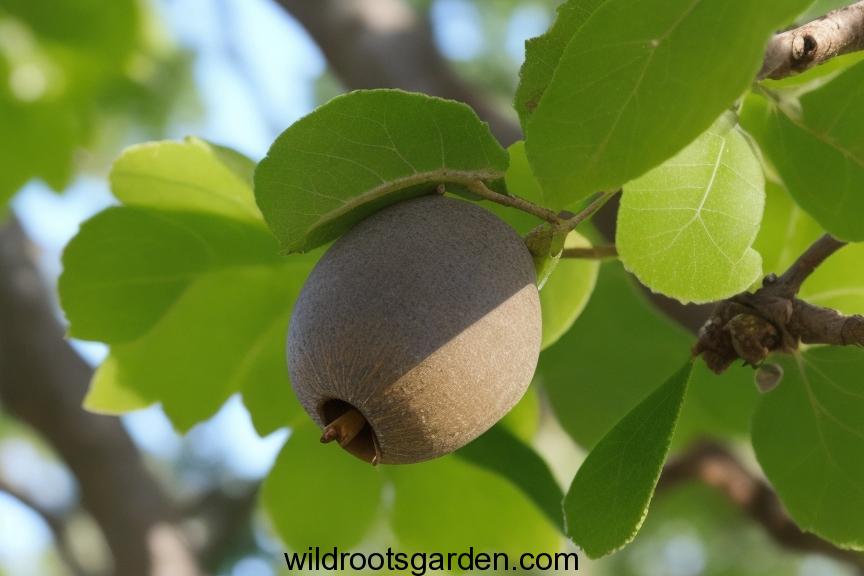
Size: The acorns of the Coast Live Oak are generally on the smaller side compared to some other oak species. They typically measure around 1 to 2.5 cm (0.4 to 1 inch) in length.
Cup (Cupule): The cupule of the Coast Live Oak acorn is shallow and bowl-shaped. It covers about one-third to half of the acorn’s length. The cupule is characterized by a distinctive wavy or ruffled appearance, which can sometimes give it a fringed look.
Color: The color of the Coast Live Oak acorn can vary, but it often has a light to medium brown hue. It can sometimes have subtle reddish or golden undertones.
Shape: The acorns are generally ovoid or egg-shaped, with a slightly flattened base. The tip of the acorn is often rounded.
Oak Group: The Coast Live Oak belongs to the “white oak” group, scientifically known as the Quercus sect. Quercus. White oaks typically have rounded lobes on their leaves, acorns that mature in one year, and acorns with a sweet or less bitter taste compared to red oaks.
Remember that there can be some variation in these characteristics due to factors such as environmental conditions, location, and individual tree variability. When identifying species, it’s always a good idea to refer to a reliable field guide specific to your region or consult with local experts who have knowledge of the native flora.
The acorns of the White Oak (Quercus alba)
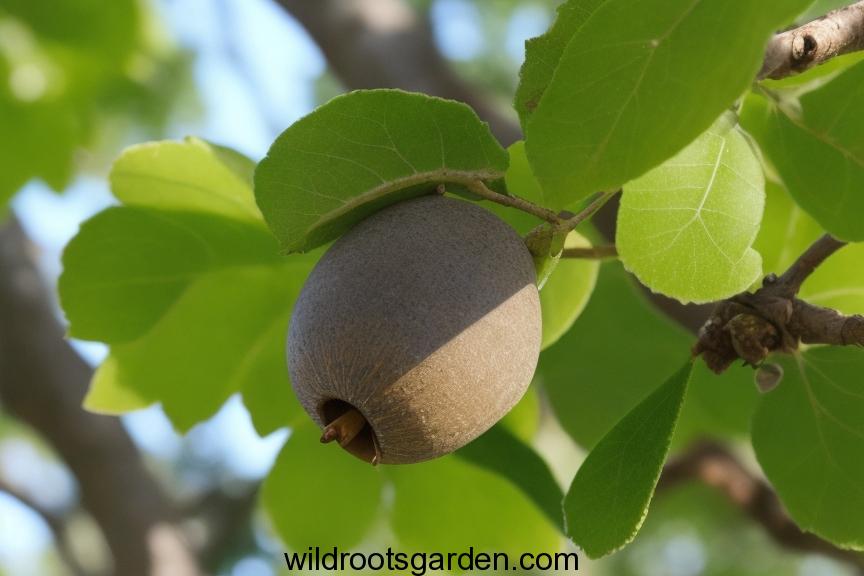
Size: The acorns of the White Oak are typically medium to large in size. They can range from around 2.5 to 5 cm (1 to 2 inches) in length.
Cup (Cupule): The cupule of the White Oak acorn is shallow and bowl-shaped, much like a cap. It covers about one-fourth to one-third of the acorn’s length. The edges of the cupule are often smooth or slightly wavy.
Color: The color of the White Oak acorn can vary, but it usually has a light to medium brown color. Sometimes, there might be hints of gray or a slightly reddish hue.
Shape: The acorns are generally ovoid or oval-shaped, with a slightly pointed tip. They are broader at the base and taper towards the top.
Oak Group: The White Oak belongs to the “white oak” group, scientifically known as Quercus sect. Quercus. White oaks typically have rounded lobes on their leaves, acorns that mature in one year, and acorns with a sweet or less bitter taste compared to red oaks.
Remember that these descriptions provide a general overview of the characteristics of White Oak acorns. When identifying species, it’s always best to refer to a reliable field guide specific to your region or consult with local experts who have knowledge of the native flora.
The acorns of the Swamp White Oak (Quercus bicolor)
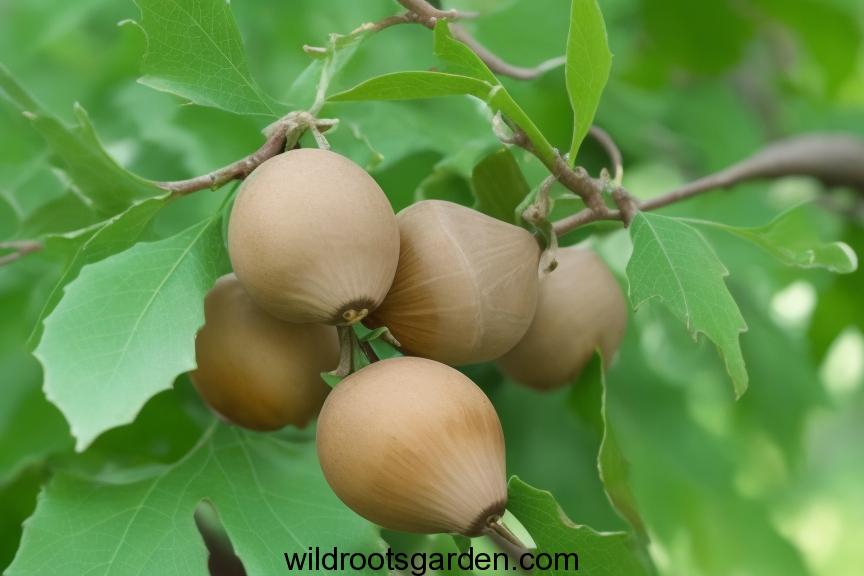
Size: The acorns of the Swamp White Oak are typically medium-sized. They range from about 2.5 to 4 cm (1 to 1.5 inches) in length.
Cup (Cupule): The cupule of the Swamp White Oak acorn is shallow and bowl-shaped, often resembling a saucer. It covers about one-third to one-half of the acorn’s length. The cupule’s edges can be slightly wavy or irregular.
Color: The color of the Swamp White Oak acorn can vary, but it generally has a light to medium brown hue. Sometimes, the acorns might have subtle grayish or reddish tones.
Shape: The acorns are typically ovoid or oval-shaped, with a slightly pointed tip. They have a wider base that tapers towards the top. The acorn’s overall shape is slightly flattened.
Oak Group: The Swamp White Oak belongs to the “white oak” group, scientifically known as Quercus sect. Quercus. White oaks typically have rounded lobes on their leaves, acorns that mature in one year, and acorns with a sweet or less bitter taste compared to red oaks.
Remember that these descriptions offer a general overview of the characteristics of Swamp White Oak acorns. For accurate identification, it’s recommended to refer to a reliable field guide specific to your region or consult with local experts who are familiar with the native flora.
Arkansas oak acorn( Quercus Arkansana)
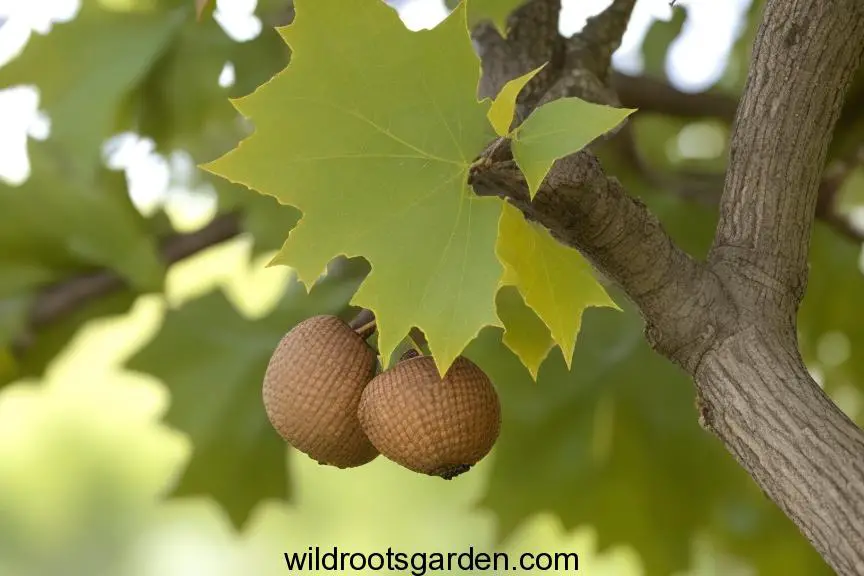
Size: The acorns of Quercus arkansana are typically small to medium in size. They range from approximately 1 to 2 cm (0.4 to 0.8 inches) in length.
Cup (Cupule): The cupule of the Quercus arkansana acorn is shallow and saucer-like. It covers about one-fourth to one-third of the acorn’s length. The cupule can have slightly wavy edges.
Color: The color of the Quercus arkansana acorn can vary, but it generally has a light to medium brown color. Depending on the specific oak and local conditions, it might exhibit shades of reddish-brown as well.
Shape: The acorns are typically ovoid or oval-shaped, with a rounded or slightly pointed tip. They have a wider base that tapers towards the top.
Oak Group: Quercus arkansana is commonly classified as a member of the “white oak” group, scientifically known as Quercus sect. Quercus. White oaks typically have rounded lobes on their leaves, acorns that mature in one year, and acorns with a sweet or less bitter taste compared to red oaks.
Please note that while these descriptions provide a general idea of the characteristics of Quercus arkansana acorns, variations can occur due to environmental factors, location, and individual tree variability. To ensure accurate identification, it’s always best to refer to a reliable field guide specific to your region or consult with local experts who are knowledgeable about the native flora.
Bastard white oak acorn(Quercus austrina)
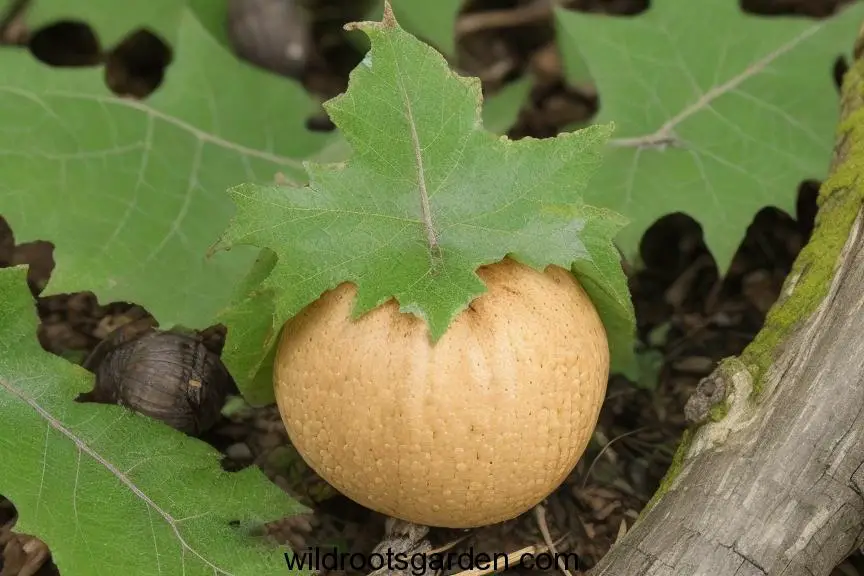
Size: The acorns of Quercus austrina are typically small to medium in size. They range from approximately 1.5 to 2.5 cm (0.6 to 1 inch) in length.
Cup (Cupule): The cupule of the Quercus austrina acorn is shallow and saucer-like. It covers about one-fourth to one-third of the acorn’s length. The cupule can have smooth or slightly wavy edges.
Color: The color of the Quercus austrina acorn can vary, but it generally has a light to medium brown color. Depending on the specific oak and local conditions, it might exhibit shades of reddish-brown or gray as well.
Shape: The acorns are typically ovoid or oval-shaped, with a rounded or slightly pointed tip. They have a broader base that tapers towards the top.
Oak Group: Quercus austrina belongs to the “white oak” group, scientifically known as Quercus sect. Quercus. White oaks typically have rounded lobes on their leaves, acorns that mature in one year, and acorns with a relatively sweet or less bitter taste compared to red oaks.
Please keep in mind that these descriptions offer a general idea of the characteristics of Quercus austrina acorns. Variations can occur due to environmental factors, location, and individual tree variability. For accurate identification, refer to a reliable field guide specific to your region or consult with local experts familiar with the native flora.
The acorns of the Swamp White Oak (Quercus bicolor)
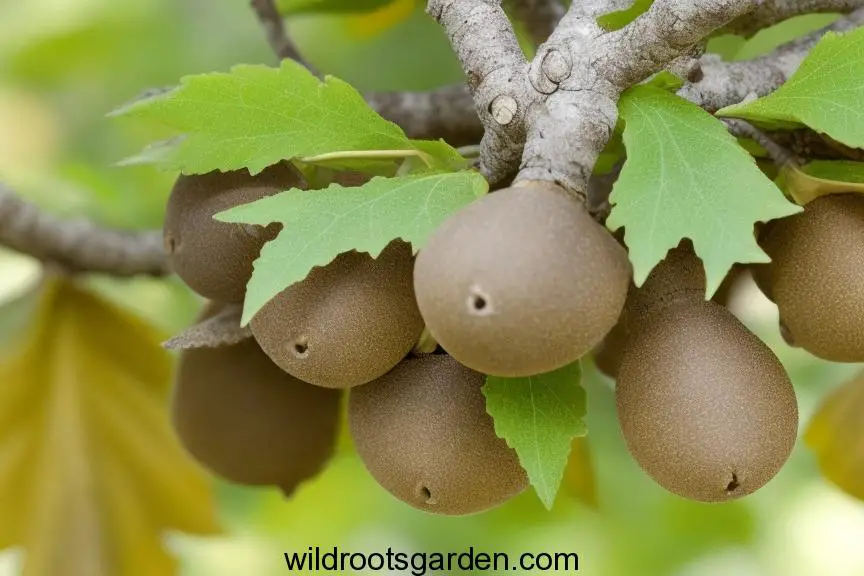
Size: The acorns of the Swamp White Oak are typically medium-sized. They range from about 2.5 to 4 cm (1 to 1.5 inches) in length.
Cup (Cupule): The cupule of the Swamp White Oak acorn is shallow and bowl-shaped, often resembling a saucer. It covers about one-third to one-half of the acorn’s length. The cupule’s edges can be slightly wavy or irregular.
Color: The color of the Swamp White Oak acorn can vary, but it generally has a light to medium brown hue. Sometimes, the acorns might have subtle grayish or reddish tones.
Shape: The acorns are typically ovoid or oval-shaped, with a slightly pointed tip. They have a wider base that tapers towards the top. The acorn’s overall shape is slightly flattened.
Oak Group: The Swamp White Oak belongs to the “white oak” group, scientifically known as Quercus sect. Quercus. White oaks typically have rounded lobes on their leaves, acorns that mature in one year, and acorns with a sweet or less bitter taste compared to red oaks.
Please note that these descriptions provide a general overview of the characteristics of Swamp White Oak acorns. For accurate identification, it’s recommended to refer to a reliable field guide specific to your region or consult with local experts who are familiar with the native flora.
Boynton oak acorn (Quercus boyntonii)

Size: The acorns of Quercus Boyntonii are relatively small in size. They typically measure around 1 to 1.5 cm (0.4 to 0.6 inches) in length.
Cup (Cupule): The cupule of the Quercus Boynton acorn is shallow and saucer-like. It covers a small portion of the acorn’s base, about one-fourth of the acorn’s length. The cupule’s edges are usually smooth.
Color: The color of the Quercus Boynton acorn can vary, but it generally has a light to medium brown hue. Depending on the specific oak and local conditions, it might exhibit shades of reddish-brown or gray as well.
Shape: The acorns are typically ovoid or oval-shaped, with a slightly pointed tip. They have a broader base that tapers towards the top.
Oak Group: Quercus Boynton is part of the “white oak” group, scientifically known as Quercus sect. Quercus. White oaks typically have rounded lobes on their leaves, acorns that mature in one year, and acorns with a relatively sweet or less bitter taste compared to red oaks.
Please note that these descriptions provide a general idea of the characteristics of Quercus Boynton acorns. Variations can occur due to environmental factors, location, and individual tree variability. For accurate identification, refer to a reliable field guide specific to your region or consult with local experts familiar with the native flora.
The acorns of Chapman oak (Quercus chapmanii)
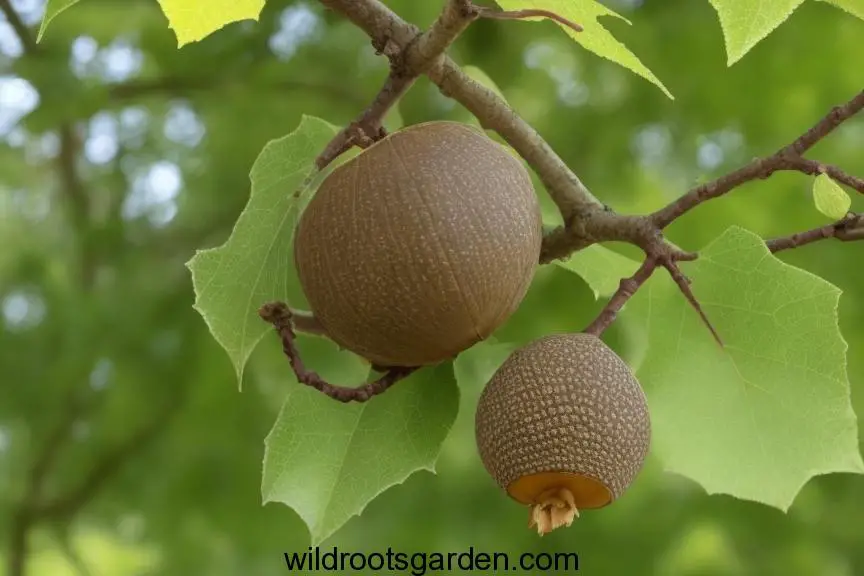
Size: The acorns of Quercus chapmanii are typically small in size. They range from about 1 to 1.5 cm (0.4 to 0.6 inches) in length.
Cup (Cupule): The cupule of the Quercus chapmanii acorn is shallow and saucer-like. It covers a small portion of the acorn’s base, about one-fourth of the acorn’s length. The cupule’s edges are usually smooth.
Color: The color of the Quercus chapmanii acorn can vary, but it generally has a light to medium brown hue. Depending on the specific oak and local conditions, it might exhibit shades of reddish-brown or gray as well.
Shape: The acorns are typically ovoid or oval-shaped, with a slightly pointed tip. They have a broader base that tapers towards the top.
Oak Group: Quercus chapmanii is part of the “white oak” group, scientifically known as Quercus sect. Quercus. White oaks typically have rounded lobes on their leaves, acorns that mature in one year, and acorns with a relatively sweet or less bitter taste compared to red oaks.
Please note that these descriptions provide a general idea of the characteristics of Quercus chapmanii acorns. Variations can occur due to environmental factors, location, and individual tree variability. For accurate identification, refer to a reliable field guide specific to your region or consult with local experts familiar with the native flora.
The acorns of the Scarlet Oak (Quercus coccinea)
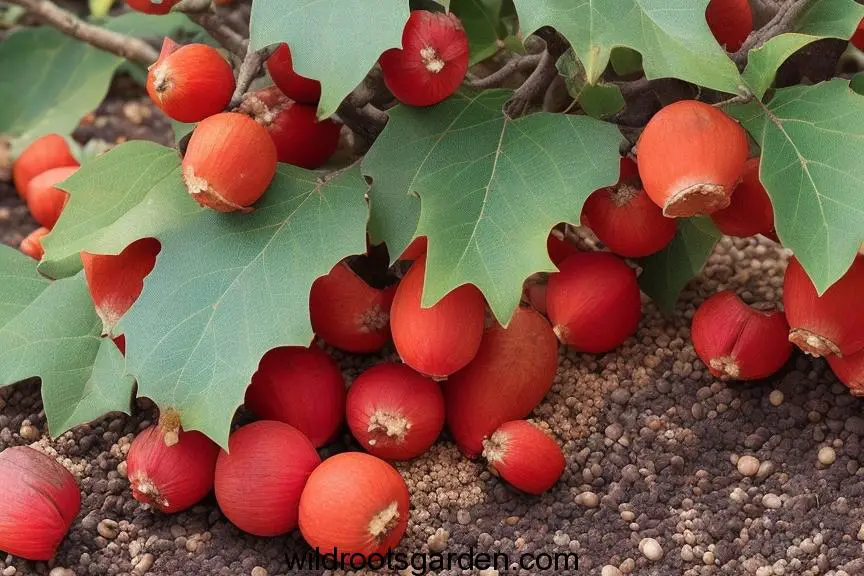
Size: The acorns of the Scarlet Oak are medium-sized. They typically measure around 1.5 to 2.5 cm (0.6 to 1 inch) in length.
Cup (Cupule): The cupule of the Scarlet Oak acorn is shallow and saucer-like. It covers about one-third to one-half of the acorn’s length. The cupule has tight, overlapping scales that give it a distinctive fringed appearance.
Color: The color of the Scarlet Oak acorn can vary, but it generally has a medium to dark brown color. The cupule can sometimes be a paler, yellowish-green color.
Shape: The acorns are typically ovoid or oval-shaped, with a rounded tip. They have a broader base that tapers towards the top.
Oak Group: The Scarlet Oak belongs to the “red oak” group, scientifically known as Quercus sect. Lobatae. Red oaks usually have pointed lobes on their leaves, acorns that take two years to mature, and acorns that are often bitter and contain a higher tannin content than white oak acorns.
Please note that these descriptions offer a general idea of the characteristics of Scarlet Oak acorns. Variations can occur due to environmental factors, location, and individual tree variability. For accurate identification, it’s recommended to refer to a reliable field guide specific to your region or consult with local experts familiar with the native flora.
The acorns of the Northern Pin Oak (Quercus ellipsoidalis)
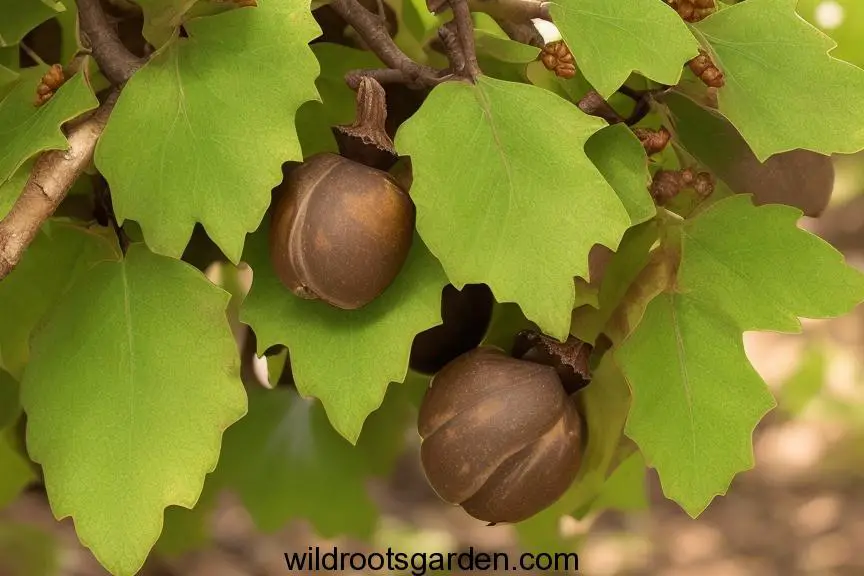
Size: The acorns of the Northern Pin Oak are relatively small in size. They typically measure around 1 to 1.5 cm (0.4 to 0.6 inches) in length.
Cup (Cupule): The cupule of the Northern Pin Oak acorn is shallow and saucer-like. It covers a small portion of the acorn’s base, about one-fourth to one-third of the acorn’s length. The cupule’s edges are often smooth.
Color: The color of the Northern Pin Oak acorn can vary, but it generally has a light to medium brown color. The cupule can sometimes be a paler, yellowish color.
Shape: The acorns are typically ovoid or oval-shaped, with a slightly pointed tip. They have a broader base that tapers towards the top.
Oak Group: The Northern Pin Oak is a member of the “red oak” group, scientifically known as Quercus sect. Lobatae. Red oaks usually have pointed lobes on their leaves, acorns that take two years to mature, and acorns that are often bitter and contain a higher tannin content compared to white oak acorns.
Please keep in mind that these descriptions provide a general idea of the characteristics of Northern Pin Oak acorns. Variations can occur due to environmental factors, location, and individual tree variability. For accurate identification, refer to a reliable field guide specific to your region or consult with local experts familiar with the native flora.
The acorns of the Southern Red Oak (Quercus falcata)
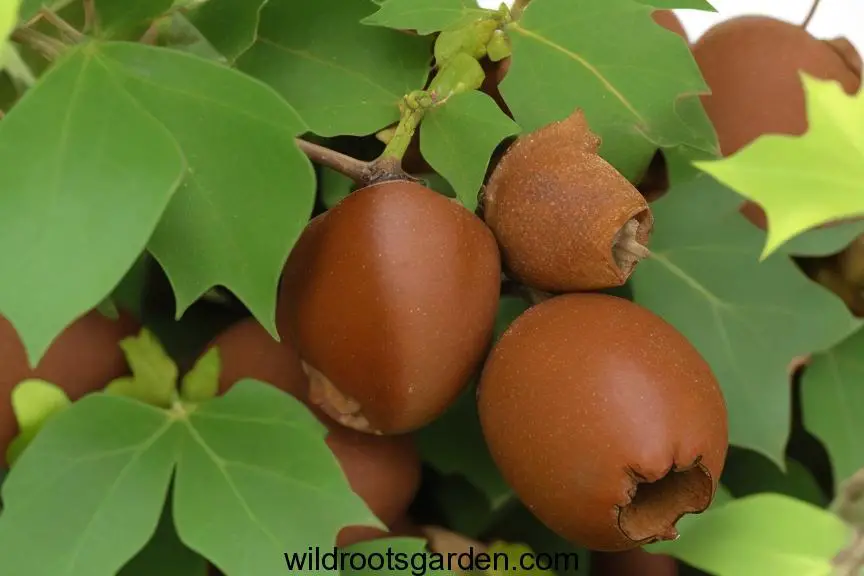
Size: The acorns of the Southern Red Oak are typically medium-sized. They range from about 1.5 to 2.5 cm (0.6 to 1 inch) in length.
Cup (Cupule): The cupule of the Southern Red Oak acorn is deep and bowl-shaped. It covers about one-third to one-half of the acorn’s length. The cupule is characterized by large, fringed scales that often curve outward.
Color: The color of the Southern Red Oak acorn can vary, but it generally has a light to medium brown color. The cupule can sometimes be a lighter, yellowish or reddish-brown color.
Shape: The acorns are typically ovoid or oval-shaped, with a slightly pointed tip. They have a broader base that tapers towards the top.
Oak Group: The Southern Red Oak belongs to the “red oak” group, scientifically known as Quercus sect. Lobatae. Red oaks usually have pointed lobes on their leaves, acorns that take two years to mature, and acorns that are often bitter and contain a higher tannin content compared to white oak acorns.
Please remember that these descriptions provide a general idea of the characteristics of Southern Red Oak acorns. Variations can occur due to environmental factors, location, and individual tree variability. For accurate identification, refer to a reliable field guide specific to your region or consult with local experts familiar with the native flora.
The acorns of the Sand Live Oak (Quercus geminata)
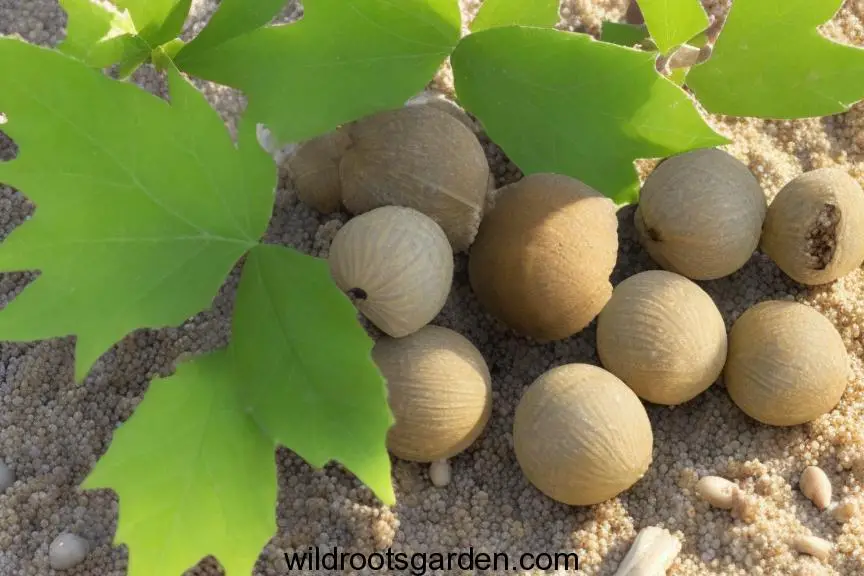
Size: The acorns of the Sand Live Oak are typically small in size, measuring around 1 to 2 cm (0.4 to 0.8 inches) in length.
Cup (Cupule): The cupule of the Sand Live Oak acorn is shallow and saucer-like. It covers a small portion of the acorn’s base, about one-fourth to one-third of the acorn’s length. The cupule’s edges are often smooth.
Color: The color of the Sand Live Oak acorn can vary, but it generally has a light to medium brown hue. The cupule is usually a similar color.
Shape: The acorns are typically ovoid or oval-shaped, with a rounded tip. They have a broader base that tapers towards the top.
Oak Group: The Sand Live Oak is a member of the “white oak” group, scientifically known as Quercus sect. Quercus. White oaks usually have rounded lobes on their leaves, acorns that mature in one year, and acorns with a relatively sweet or less bitter taste compared to red oaks.
Please note that these descriptions provide a general idea of the characteristics of Sand Live Oak acorns. Variations can occur due to environmental factors, location, and individual tree variability. For accurate identification, refer to a reliable field guide specific to your region or consult with local experts familiar with the native flora.
The acorns of the Georgia Oak (Quercus georgiana)
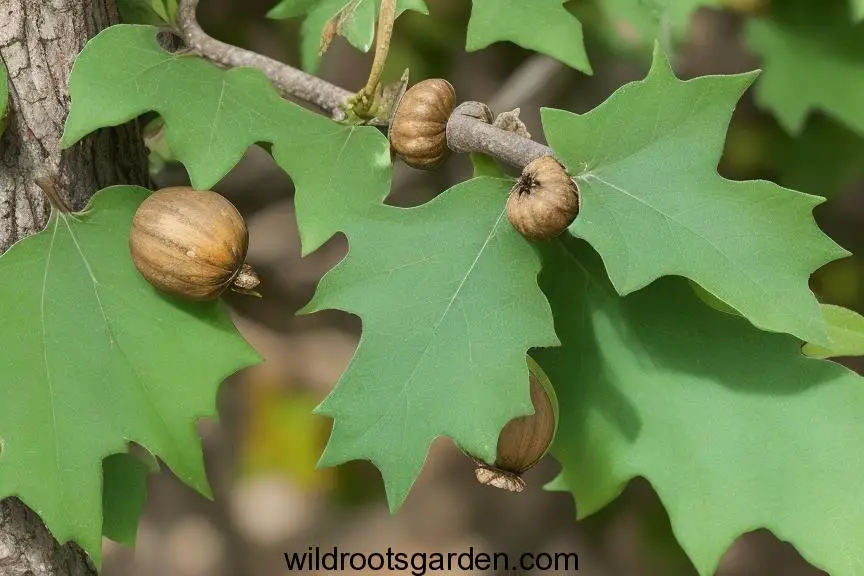
Size: The acorns of the Georgia Oak are usually small to medium in size, ranging from approximately 1.5 to 2.5 cm (0.6 to 1 inch) in length.
Cup (Cupule): The cupule of the Georgia Oak acorn is shallow and saucer-like. It covers a small portion of the acorn’s base, about one-fourth to one-third of the acorn’s length. The cupule’s edges are often smooth.
Color: The color of the Georgia Oak acorn can vary, but it generally has a light to medium brown hue. The cupule is usually a similar color.
Shape: The acorns are typically ovoid or oval-shaped, with a rounded tip. They have a broader base that tapers towards the top.
Oak Group: The Georgia Oak is also a member of the “white oak” group, scientifically known as Quercus sect. Quercus. White oaks usually have rounded lobes on their leaves, acorns that mature in one year, and acorns with a relatively sweet or less bitter taste compared to red oaks.
Please note that these descriptions provide a general idea of the characteristics of Georgia Oak acorns. Variations can occur due to environmental factors, location, and individual tree variability. For accurate identification, refer to a reliable field guide specific to your region or consult with local experts familiar with the native flora.
The acorns of the Laurel Oak (Quercus laurifolia)
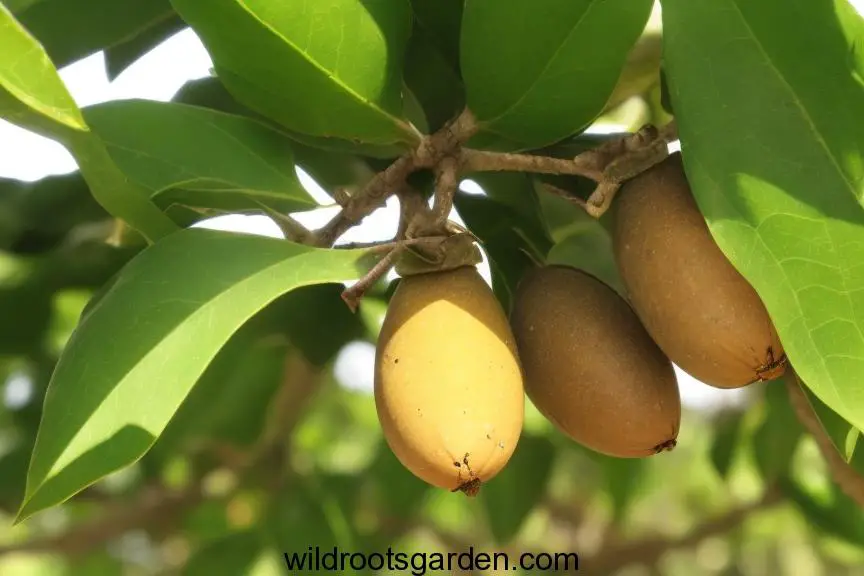
Size: The acorns of the Laurel Oak are typically medium-sized, ranging from about 1.5 to 2.5 cm (0.6 to 1 inch) in length.
Cup (Cupule): The cupule of the Laurel Oak acorn is shallow and saucer-like. It covers a small portion of the acorn’s base, usually about one-fourth to one-third of the acorn’s length. The cupule’s edges can be smooth or slightly wavy.
Color: The color of the Laurel Oak acorn can vary, but it generally has a light to medium brown hue. The cupule is usually a similar color to the acorn.
Shape: The acorns are typically ovoid or oval-shaped, with a rounded tip. They have a broader base that tapers towards the top.
Oak Group: The Laurel Oak is part of the “red oak” group, scientifically known as Quercus sect. Lobatae. Red oaks usually have pointed lobes on their leaves, acorns that take two years to mature, and acorns that are often bitter and contain a higher tannin content compared to white oak acorns.
Please note that these descriptions provide a general idea of the characteristics of Laurel Oak acorns. Variations can occur due to environmental factors, location, and individual tree variability. For accurate identification, refer to a reliable field guide specific to your region or consult with local experts familiar with the native flora.
The acorns of the Bear Oak (Quercus ilicifolia)
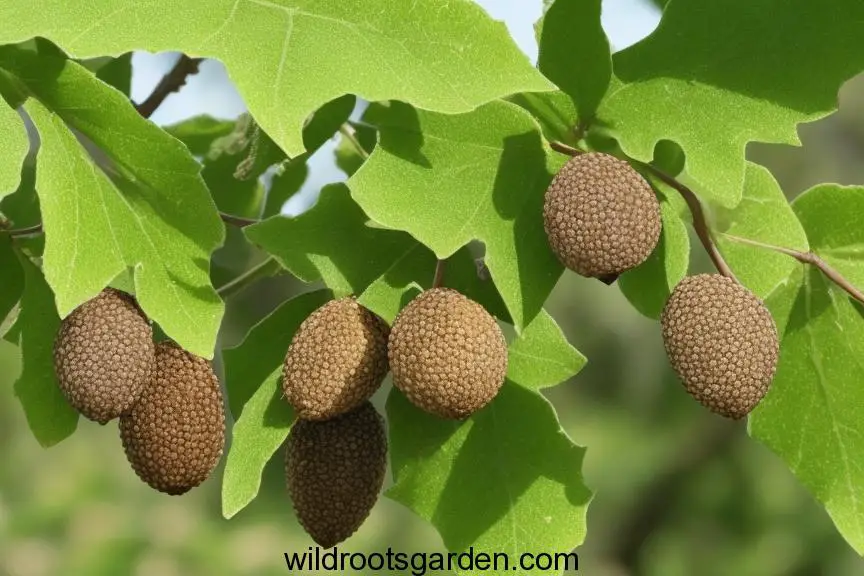
Size: The acorns of the Bear Oak are typically small in size, ranging from about 1 to 2 cm (0.4 to 0.8 inches) in length.
Cup (Cupule): The cupule of the Bear Oak acorn is shallow and saucer-like. It covers a small portion of the acorn’s base, usually about one-fourth to one-third of the acorn’s length. The cupule’s edges can be smooth or slightly wavy.
Color: The color of the Bear Oak acorn can vary, but it generally has a light to medium brown hue. The cupule is typically a similar color to the acorn.
Shape: The acorns are typically ovoid or oval-shaped, with a rounded tip. They have a broader base that tapers towards the top.
Oak Group: The Bear Oak is part of the “red oak” group, scientifically known as Quercus sect. Lobatae. Red oaks usually have pointed lobes on their leaves, acorns that take two years to mature, and acorns that are often bitter and contain a higher tannin content compared to white oak acorns.
Please keep in mind that these descriptions provide a general idea of the characteristics of Bear Oak acorns. Variations can occur due to environmental factors, location, and individual tree variability. For accurate identification, refer to a reliable field guide specific to your region or consult with local experts familiar with the native flora.
The acorns of the Shingle Oak (Quercus imbricaria)
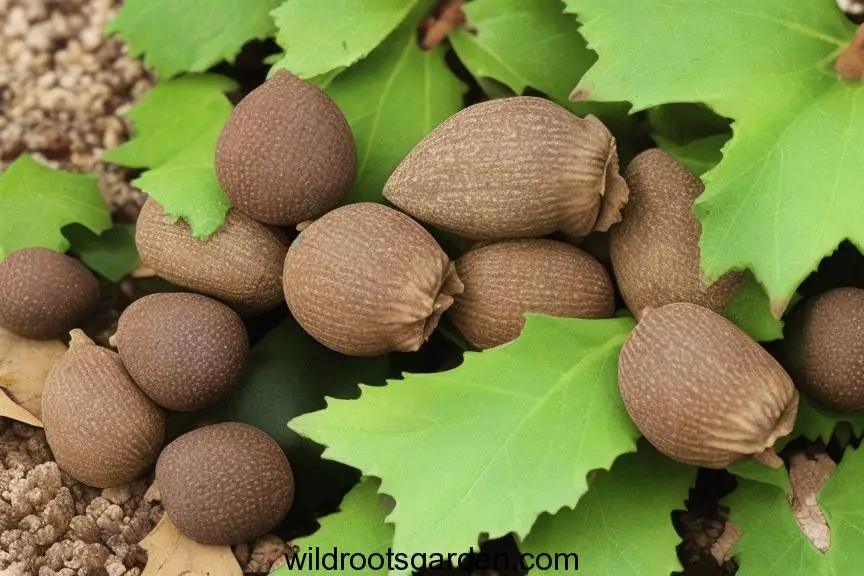
Size: The acorns of the Shingle Oak are typically small to medium in size, ranging from about 1.5 to 2.5 cm (0.6 to 1 inch) in length.
Cup (Cupule): The cupule of the Shingle Oak acorn is shallow and saucer-like. It covers a small portion of the acorn’s base, usually about one-fourth to one-third of the acorn’s length. The cupule’s edges are often smooth or slightly wavy.
Color: The color of the Shingle Oak acorn can vary, but it generally has a light to medium brown hue. The cupule is typically a similar color to the acorn.
Shape: The acorns are typically ovoid or oval-shaped, with a rounded tip. They have a broader base that tapers towards the top.
Oak Group: The Shingle Oak is part of the “red oak” group, scientifically known as Quercus sect. Lobatae. Red oaks usually have pointed lobes on their leaves, acorns that take two years to mature, and acorns that are often bitter and contain a higher tannin content compared to white oak acorns.
Please remember that these descriptions provide a general idea of the characteristics of Shingle Oak acorns. Variations can occur due to environmental factors, location, and individual tree variability. For accurate identification, refer to a reliable field guide specific to your region or consult with local experts familiar with the native flora.
The acorns of the Bluejack Oak (Quercus incana)
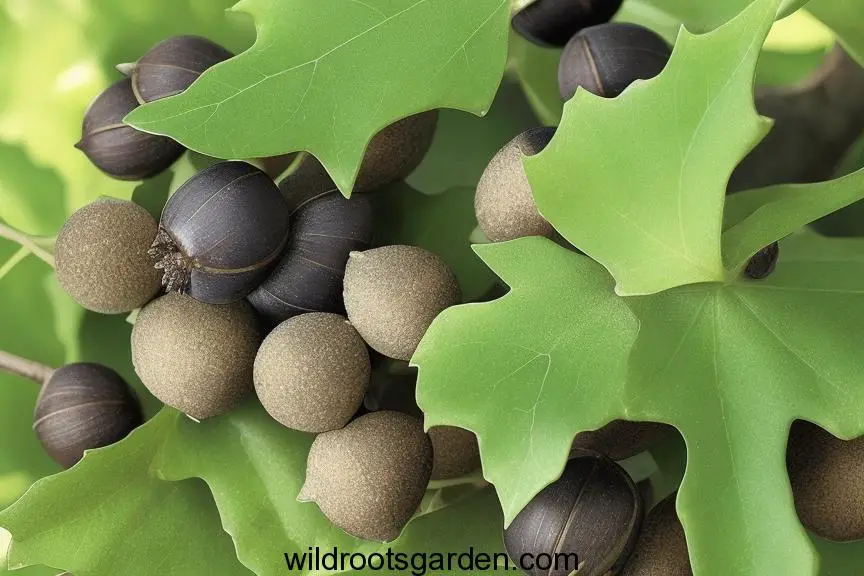
Size: The acorns of the Bluejack Oak are typically small in size, ranging from about 1.5 to 2.5 cm (0.6 to 1 inch) in length.
Cup (Cupule): The cupule of the Bluejack Oak acorn is shallow and saucer-like. It covers a small portion of the acorn’s base, usually about one-fourth to one-third of the acorn’s length. The cupule’s edges are often smooth or slightly wavy.
Color: The color of the Bluejack Oak acorn can vary, but it generally has a light to medium brown hue. The cupule is typically a similar color to the acorn.
Shape: The acorns are typically ovoid or oval-shaped, with a rounded tip. They have a broader base that tapers towards the top.
Oak Group: The Bluejack Oak is part of the “red oak” group, scientifically known as Quercus sect. Lobatae. Red oaks usually have pointed lobes on their leaves, acorns that take two years to mature, and acorns that are often bitter and contain a higher tannin content compared to white oak acorns.
Please remember that these descriptions provide a general idea of the characteristics of Bluejack Oak acorns. Variations can occur due to environmental factors, location, and individual tree variability. For accurate identification, refer to a reliable field guide specific to your region or consult with local experts familiar with the native flora.
The acorn of the Florida oak (quercus)
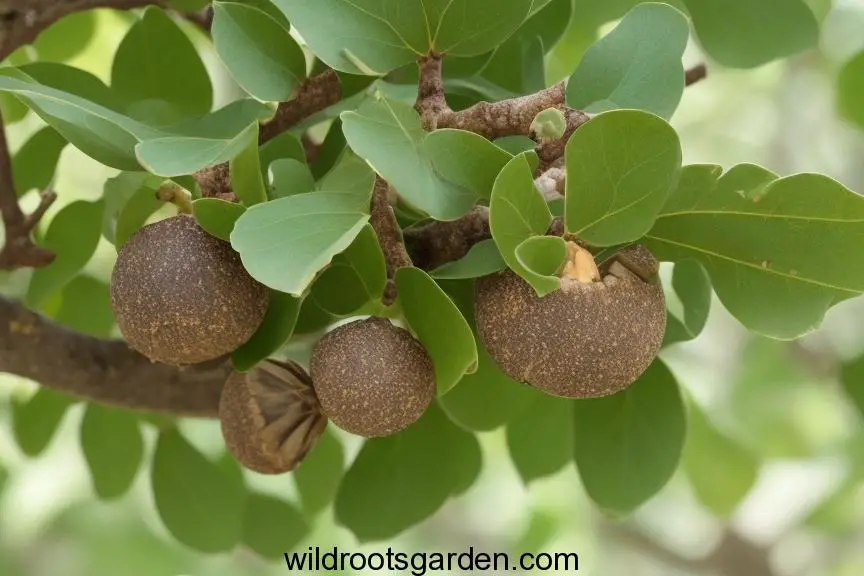
Size: Acorn sizes can vary among oak species, but generally, they range from small to medium, with lengths of around 1.5 to 3.5 cm (0.6 to 1.4 inches).
Cup (Cupule): The cupule, also known as the cap or cup, can have a saucer-like or bowl-shaped appearance. Its size and depth vary among oak species, covering about one-fourth to one-half of the acorn’s length.
Color: Acorns and their cupules typically have a range of brown hues, from light to medium brown. However, colors can vary based on the specific oak species.
Shape: Acorns generally have an ovoid or oval shape, with a broader base and a narrower, rounded tip.
Oak Group: The oak group varies depending on the specific oak species. Oaks are commonly categorized into two main groups: the “red oak” group (Quercus sect. Lobatae) and the “white oak” group (Quercus sect. Quercus). Red oaks have pointed leaf lobes, bitter-tasting acorns that take two years to mature, and high tannin content. White oaks have rounded leaf lobes, acorns that mature in one year, and relatively sweeter-tasting acorns.
To accurately describe the acorns of a specific oak tree in Florida, it’s crucial to know the scientific name of the oak species you’re referring to. If you have access to the scientific name, I’d be happy to help you provide more detailed information.
The acorn of the Turkey Oak (Quercus laevis)
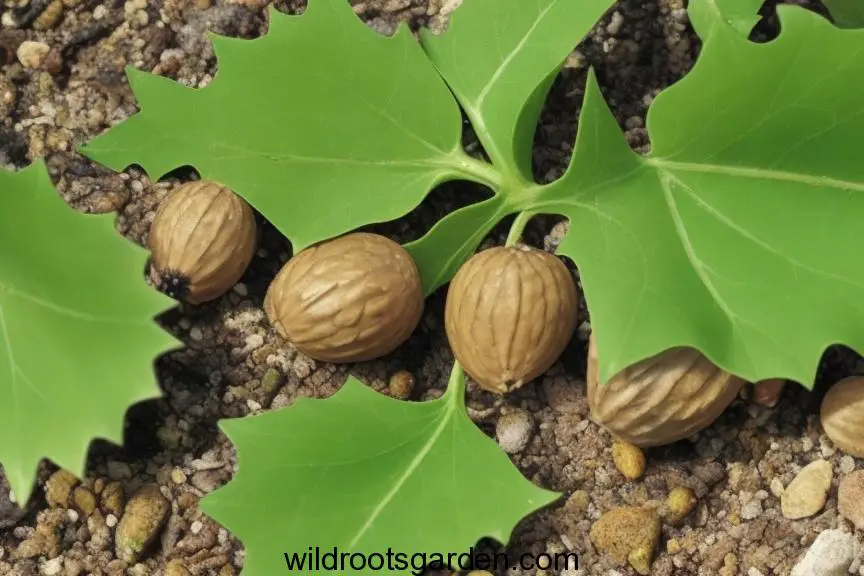
Size: The acorns of the Turkey Oak are typically small to medium in size, ranging from about 1.5 to 2.5 cm (0.6 to 1 inch) in length.
Cup (Cupule): The cupule of the Turkey Oak acorn is shallow and saucer-like. It covers a small portion of the acorn’s base, usually about one-fourth to one-third of the acorn’s length. The cupule’s edges can be smooth or slightly wavy.
Color: The color of the Turkey Oak acorn can vary, but it generally has a light to medium brown hue. The cupule is typically a similar color to the acorn.
Shape: The acorns are typically ovoid or oval-shaped, with a rounded tip. They have a broader base that tapers towards the top.
Oak Group: The Turkey Oak is part of the “red oak” group, scientifically known as Quercus sect. Lobatae. Red oaks usually have pointed lobes on their leaves, acorns that take two years to mature, and acorns that are often bitter and contain a higher tannin content compared to white oak acorns.
Please remember that these descriptions provide a general idea of the characteristics of Turkey Oak acorns. Variations can occur due to environmental factors, location, and individual tree variability. For accurate identification, refer to a reliable field guide specific to your region or consult with local experts familiar with the native flora.
The acorn of the Swamp Laurel Oak (Quercus laurifolia)
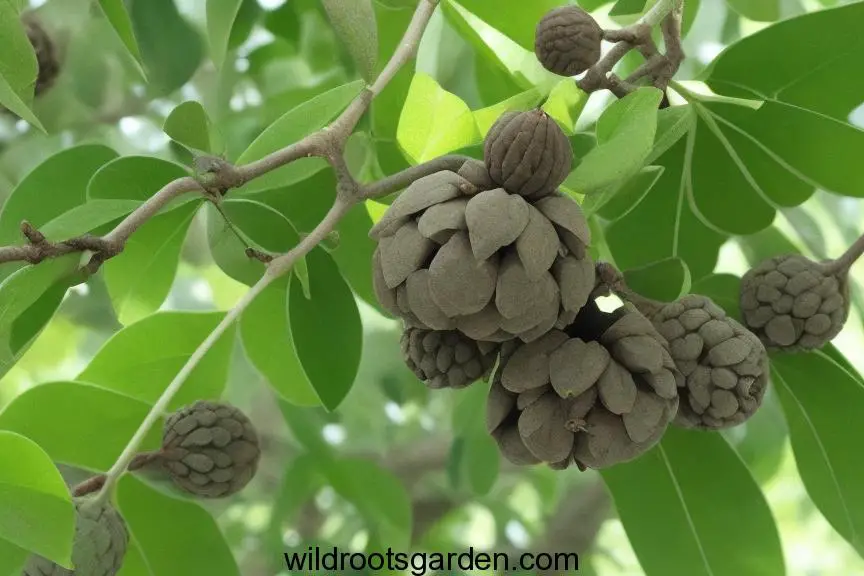
Size: The acorns of the Swamp Laurel Oak are typically medium-sized, ranging from about 1.5 to 2.5 cm (0.6 to 1 inch) in length.
Cup (Cupule): The cupule of the Swamp Laurel Oak acorn is shallow and saucer-like. It covers a small portion of the acorn’s base, usually about one-fourth to one-third of the acorn’s length. The cupule’s edges can be smooth or slightly wavy.
Color: The color of the Swamp Laurel Oak acorn can vary, but it generally has a light to medium brown hue. The cupule is typically a similar color to the acorn.
Shape: The acorns are typically ovoid or oval-shaped, with a rounded tip. They have a broader base that tapers towards the top.
Oak Group: The Swamp Laurel Oak is part of the “red oak” group, scientifically known as Quercus sect. Lobatae. Red oaks usually have pointed lobes on their leaves, acorns that take two years to mature, and acorns that are often bitter and contain a higher tannin content compared to white oak acorns.
Please remember that these descriptions provide a general idea of the characteristics of Swamp Laurel Oak acorns. Variations can occur due to environmental factors, location, and individual tree variability. For accurate identification, refer to a reliable field guide specific to your region or consult with local experts familiar with the native flora.
The Acorn of the Overcup Oak (Quercus lyrata)
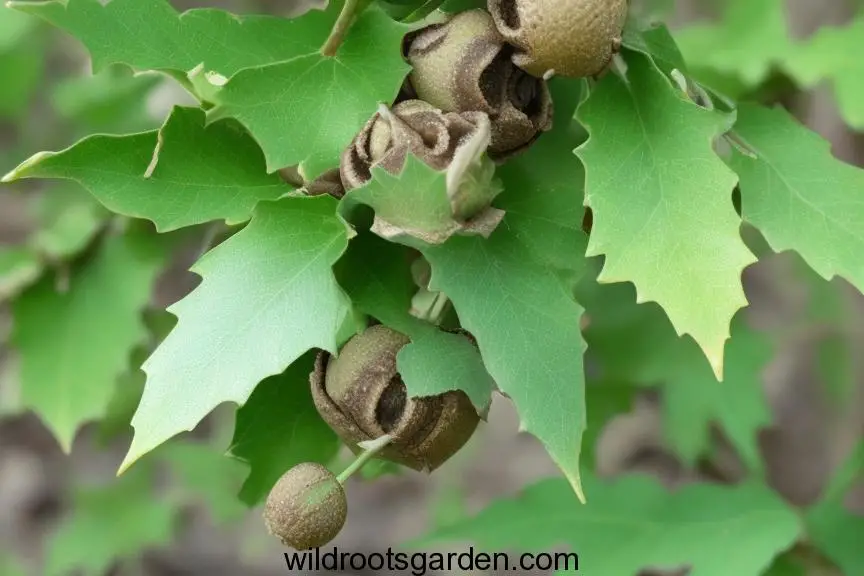
Size: The acorns of the Overcup Oak are typically medium to large in size, ranging from about 2.5 to 4 cm (1 to 1.6 inches) in length.
Cup (Cupule): The cupule of the Overcup Oak acorn is distinctively large and almost completely encloses the acorn. The cupule is often referred to as an “overcup,” and it covers a significant portion of the acorn’s base, sometimes even nearly enveloping the entire acorn. The edges of the cupule can be wavy and slightly fringed.
Color: The color of the Overcup Oak acorn can vary, but it generally has a light to medium brown hue. The cupule is typically a similar color to the acorn.
Shape: The acorns are typically ovoid or oval-shaped, with a rounded tip. They have a broader base that tapers towards the top.
Oak Group: The Overcup Oak is part of the “white oak” group, scientifically known as Quercus sect. Quercus. White oaks usually have rounded lobes on their leaves, acorns that mature in one year, and acorns with a relatively sweet or less bitter taste compared to red oak acorns.
Please note that these descriptions provide a general idea of the characteristics of Overcup Oak acorns. Variations can occur due to environmental factors, location, and individual tree variability. For accurate identification, refer to a reliable field guide specific to your region or consult with local experts familiar with the native flora.
The acorn of the Bur Oak (Quercus macrocarpa)
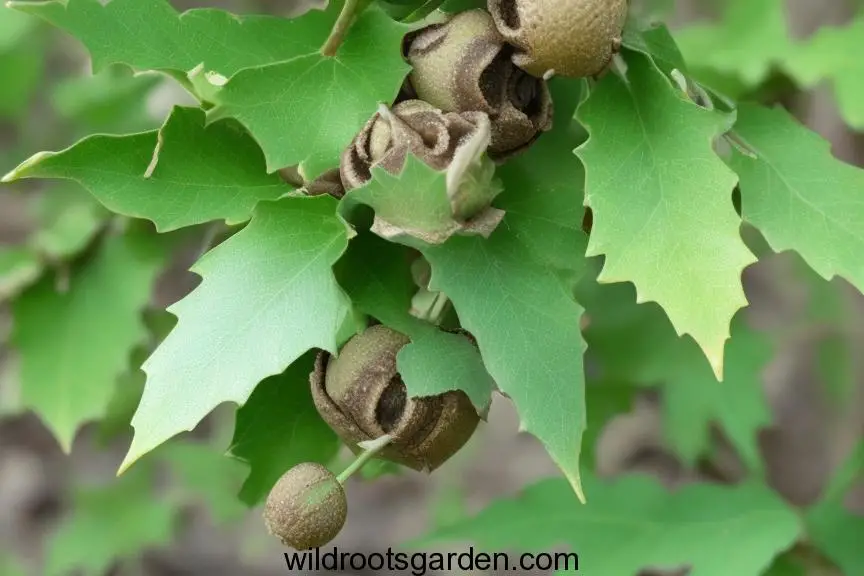
Size: The acorns of the Bur Oak are relatively large, measuring around 4 to 6 cm (1.6 to 2.4 inches) in length. They are among the largest of North American oak species.
Cup (Cupule): The cupule of the Bur Oak acorn is large and deep. It covers a significant portion of the acorn’s base, usually about one-third to half of the acorn’s length. The cupule’s edges are often fringed and slightly wavy.
Color: The color of the Bur Oak acorn can vary, but it generally has a light to medium brown hue. The cupule often shares a similar color to the acorn.
Shape: The acorns are ovoid or oval-shaped, with a rounded tip. They have a broader base that tapers towards the top.
Oak Group: The Bur Oak is part of the “white oak” group, scientifically known as Quercus sect. Quercus. White oaks typically have rounded lobes on their leaves, acorns that mature in one year, and acorns with a relatively sweet or less bitter taste compared to red oak acorns.
Please remember that these descriptions provide a general idea of the characteristics of Bur Oak acorns. Variations can occur due to environmental factors, location, and individual tree variability. For accurate identification, refer to a reliable field guide specific to your region or consult with local experts familiar with the native flora.
The acorn of the Bur Oak (Quercus macrocarpa)
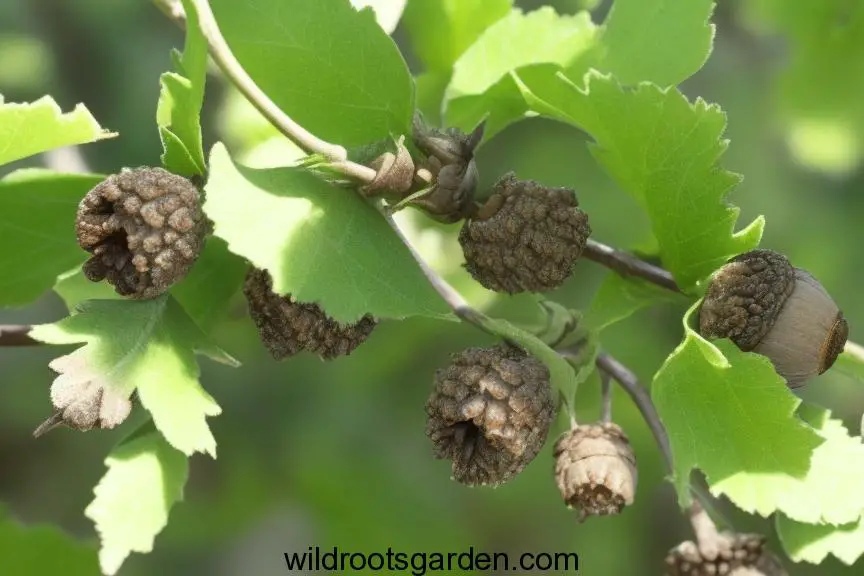
Size: The acorns of the Bur Oak are relatively large, measuring around 4 to 6 cm (1.6 to 2.4 inches) in length. They are among the largest of North American oak species.
Cup (Cupule): The cupule of the Bur Oak acorn is large and deep. It covers a significant portion of the acorn’s base, usually about one-third to half of the acorn’s length. The cupule’s edges are often fringed and slightly wavy.
Color: The color of the Bur Oak acorn can vary, but it generally has a light to medium brown hue. The cupule often shares a similar color to the acorn.
Shape: The acorns are ovoid or oval-shaped, with a rounded tip. They have a broader base that tapers towards the top.
Oak Group: The Bur Oak is part of the “white oak” group, scientifically known as Quercus sect. Quercus. White oaks typically have rounded lobes on their leaves, acorns that mature in one year, and acorns with a relatively sweet or less bitter taste compared to red oak acorns.
Please remember that these descriptions provide a general idea of the characteristics of Bur Oak acorns. Variations can occur due to environmental factors, location, and individual tree variability. For accurate identification, refer to a reliable field guide specific to your region or consult with local experts familiar with the native flora.
The acorn of the Blackjack Oak (Quercus marilandica)
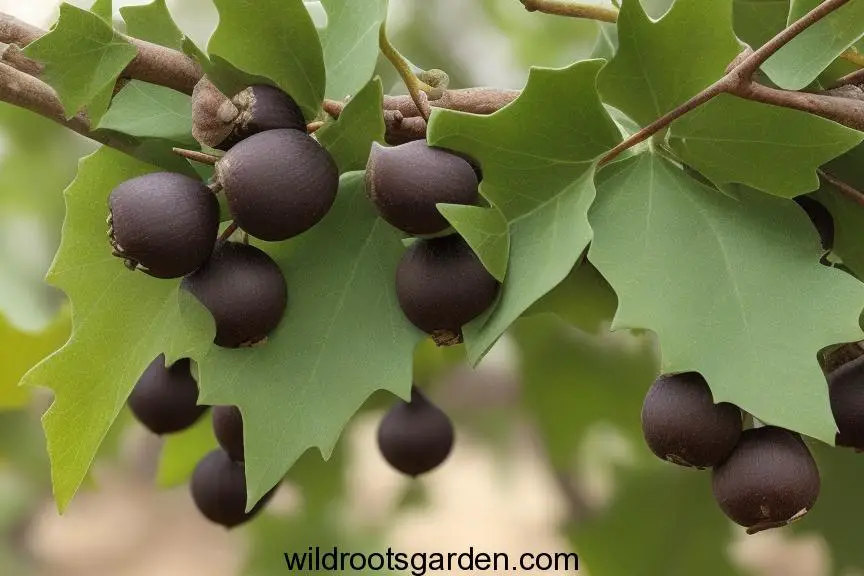
Size: The acorns of the Blackjack Oak are relatively small, measuring around 1 to 2 cm (0.4 to 0.8 inches) in length.
Cup (Cupule): The cupule of the Blackjack Oak acorn is shallow and saucer-like. It covers a small portion of the acorn’s base, usually about one-fourth to one-third of the acorn’s length. The cupule’s edges can be smooth or slightly wavy.
Color: The color of the Blackjack Oak acorn can vary, but it generally has a light to medium brown hue. The cupule is typically a similar color to the acorn.
Shape: The acorns are typically ovoid or oval-shaped, with a rounded tip. They have a broader base that tapers towards the top.
Oak Group: The Blackjack Oak is part of the “red oak” group, scientifically known as Quercus sect. Lobatae. Red oaks usually have pointed lobes on their leaves, acorns that take two years to mature, and acorns that are often bitter and contain a higher tannin content compared to white oak acorns.
Please remember that these descriptions provide a general idea of the characteristics of Blackjack Oak acorns. Variations can occur due to environmental factors, location, and individual tree variability. For accurate identification, refer to a reliable field guide specific to your region or consult with local experts familiar with the native flora.
The acorn of the Swamp Chestnut Oak (Quercus michauxii)
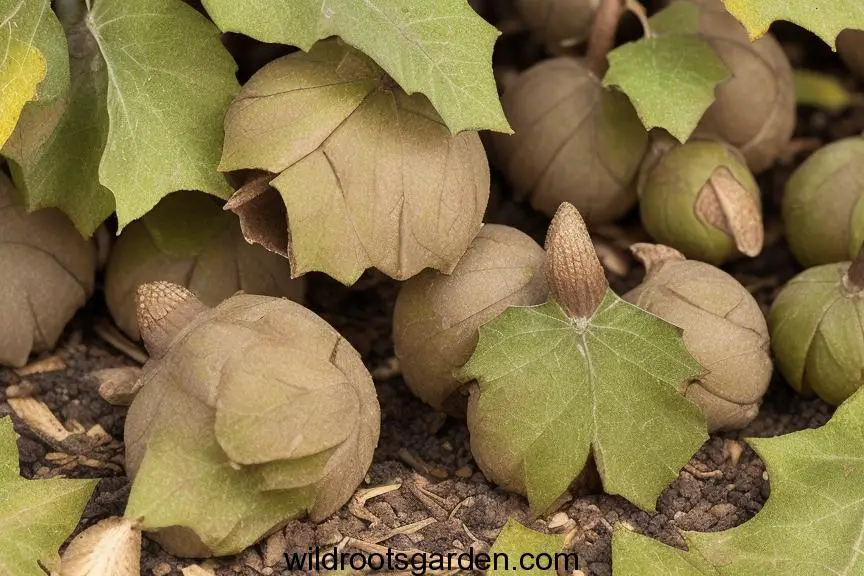
Size: The acorns of the Swamp Chestnut Oak are relatively large, measuring around 2 to 4 cm (0.8 to 1.6 inches) in length.
Cup (Cupule): The cupule of the Swamp Chestnut Oak acorn is shallow and saucer-like, covering a small portion of the acorn’s base, usually about one-fourth to one-third of the acorn’s length. The cupule’s edges can be smooth or slightly wavy.
Color: The color of the Swamp Chestnut Oak acorn can vary, but it generally has a light to medium brown hue. The cupule is usually a similar color to the acorn.
Shape: The acorns are typically ovoid or oval-shaped, with a rounded tip. They have a broader base that tapers towards the top.
Oak Group: The Swamp Chestnut Oak is part of the “white oak” group, scientifically known as Quercus sect. Quercus. White oaks usually have rounded lobes on their leaves, acorns that mature in one year, and acorns with a relatively sweet or less bitter taste compared to red oak acorns.
Please remember that these descriptions provide a general idea of the characteristics of Swamp Chestnut Oak acorns. Variations can occur due to environmental factors, location, and individual tree variability. For accurate identification, refer to a reliable field guide specific to your region or consult with local experts familiar with the native flora.
The acorn of the Dwarf Live Oak (Quercus minima)
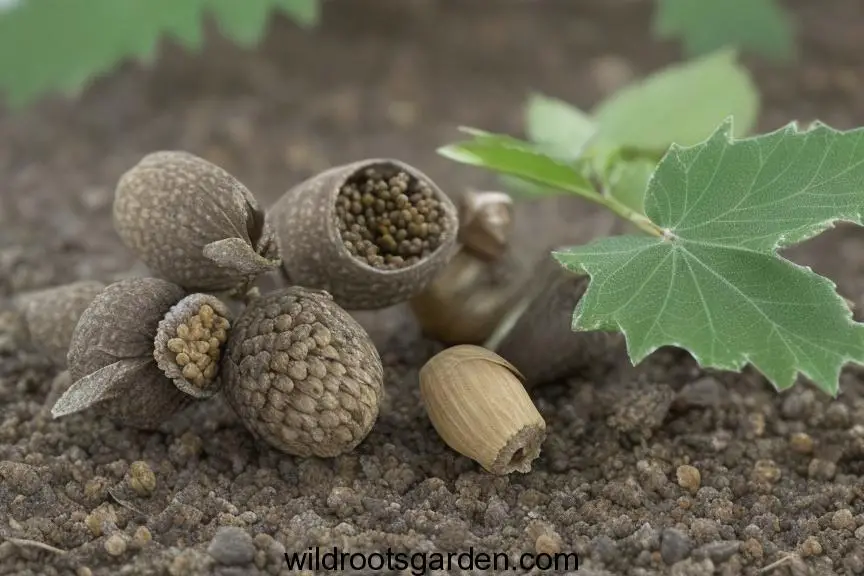
Size: The acorns of the Dwarf Live Oak are relatively small, measuring around 1 to 1.5 cm (0.4 to 0.6 inches) in length.
Cup (Cupule): The cupule of the Dwarf Live Oak acorn is shallow and saucer-like, covering a small portion of the acorn’s base, usually about one-fourth to one-third of the acorn’s length. The cupule’s edges can be smooth or slightly wavy.
Color: The color of the Dwarf Live Oak acorn can vary, but it generally has a light to medium brown hue. The cupule is usually a similar color to the acorn.
Shape: The acorns are typically ovoid or oval-shaped, with a rounded tip. They have a broader base that tapers towards the top.
Oak Group: The Dwarf Live Oak is a member of the “white oak” group, scientifically known as Quercus sect. Quercus. White oaks usually have rounded lobes on their leaves, acorns that mature in one year, and acorns with a relatively sweet or less bitter taste compared to red oak acorns.
Please remember that these descriptions provide a general idea of the characteristics of Dwarf Live Oak acorns. Variations can occur due to environmental factors, location, and individual tree variability. For accurate identification, refer to a reliable field guide specific to your region or consult with local experts familiar with the native flora.
The acorn of the Chestnut Oak (Quercus prinus)
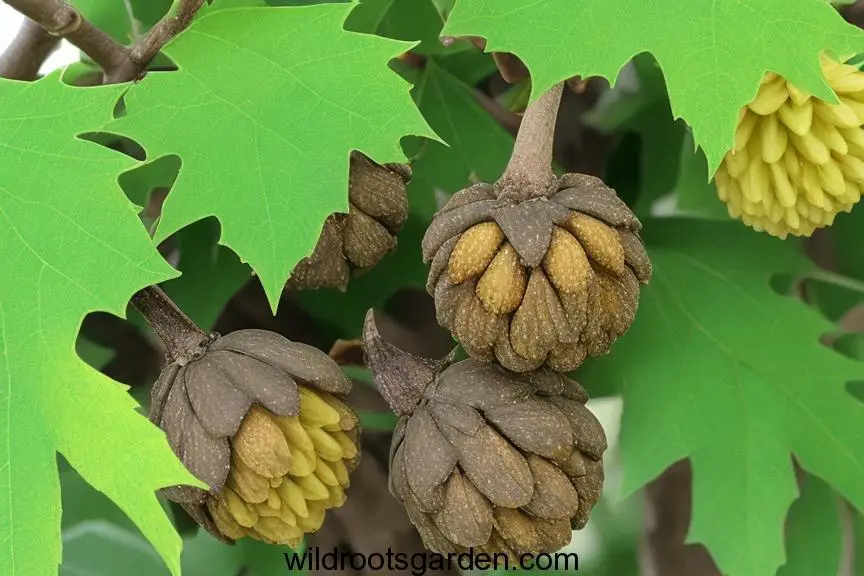
Size: The acorns of the Chestnut Oak are typically medium to large in size, measuring around 2.5 to 4 cm (1 to 1.6 inches) in length.
Cup (Cupule): The cupule of the Chestnut Oak acorn is shallow and saucer-like, covering a small portion of the acorn’s base, usually about one-fourth to one-third of the acorn’s length. The cupule’s edges can be smooth or slightly wavy.
Color: The color of the Chestnut Oak acorn can vary, but it generally has a light to medium brown hue. The cupule is typically a similar color to the acorn.
Shape: The acorns are typically ovoid or oval-shaped, with a rounded tip. They have a broader base that tapers towards the top.
Oak Group: The Chestnut Oak is a member of the “white oak” group, scientifically known as Quercus sect. Quercus. White oaks usually have rounded lobes on their leaves, acorns that mature in one year, and acorns with a relatively sweet or less bitter taste compared to red oak acorns.
Please note that these descriptions provide a general idea of the characteristics of Chestnut Oak acorns. Variations can occur due to environmental factors, location, and individual tree variability. For accurate identification, refer to a reliable field guide specific to your region or consult with local experts familiar with the native flora.
The acorn of the Chinkapin Oak (Quercus muehlenbergii)
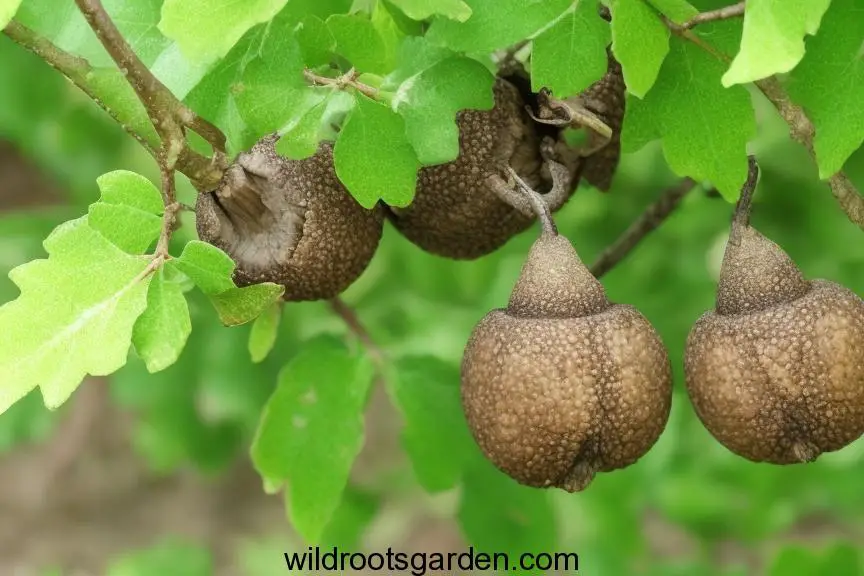
Size: The acorns of the Chinkapin Oak are relatively small to medium in size, measuring around 1 to 2.5 cm (0.4 to 1 inch) in length.
Cup (Cupule): The cupule of the Chinkapin Oak acorn is shallow and saucer-like, covering a small portion of the acorn’s base, usually about one-fourth to one-third of the acorn’s length. The cupule’s edges can be smooth or slightly wavy.
Color: The color of the Chinkapin Oak acorn can vary, but it generally has a light to medium brown hue. The cupule is usually a similar color to the acorn.
Shape: The acorns are typically ovoid or oval-shaped, with a rounded tip. They have a broader base that tapers towards the top. Chinkapin Oak acorns are often flattened or slightly flattened on the top.
Oak Group: The Chinkapin Oak is part of the “white oak” group, scientifically known as Quercus sect. Quercus. White oaks usually have rounded lobes on their leaves, acorns that mature in one year, and acorns with a relatively sweet or less bitter taste compared to red oak acorns.
Please remember that these descriptions provide a general idea of the characteristics of Chinkapin Oak acorns. Variations can occur due to environmental factors, location, and individual tree variability. For accurate identification, refer to a reliable field guide specific to your region or consult with local experts familiar with the native flora.
The acorn of the Myrtle Oak (Quercus myrtifolia)
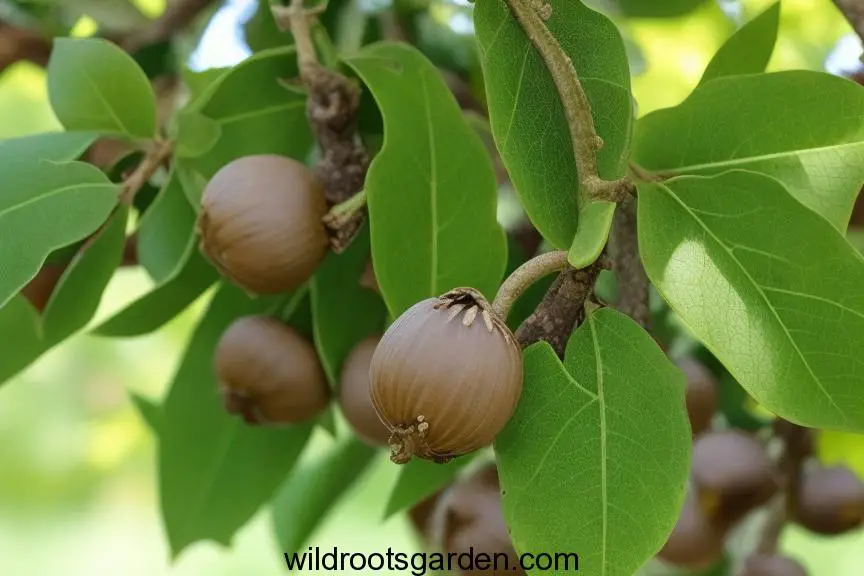
Size: The acorns of the Myrtle Oak are relatively small, measuring around 1 to 1.5 cm (0.4 to 0.6 inches) in length.
Cup (Cupule): The cupule of the Myrtle Oak acorn is shallow and saucer-like, covering a small portion of the acorn’s base, usually about one-fourth to one-third of the acorn’s length. The cupule’s edges can be smooth or slightly wavy.
Color: The color of the Myrtle Oak acorn can vary, but it generally has a light to medium brown hue. The cupule is usually a similar color to the acorn.
Shape: The acorns are typically ovoid or oval-shaped, with a rounded tip. They have a broader base that tapers towards the top.
Oak Group: The Myrtle Oak is part of the “white oak” group, scientifically known as Quercus sect. Quercus. White oaks usually have rounded lobes on their leaves, acorns that mature in one year, and acorns with a relatively sweet or less bitter taste compared to red oak acorns.
Please remember that these descriptions provide a general idea of the characteristics of Myrtle Oak acorns. Variations can occur due to environmental factors, location, and individual tree variability. For accurate identification, refer to a reliable field guide specific to your region or consult with local experts familiar with the native flora.
The acorn of the Water Oak (Quercus nigra)
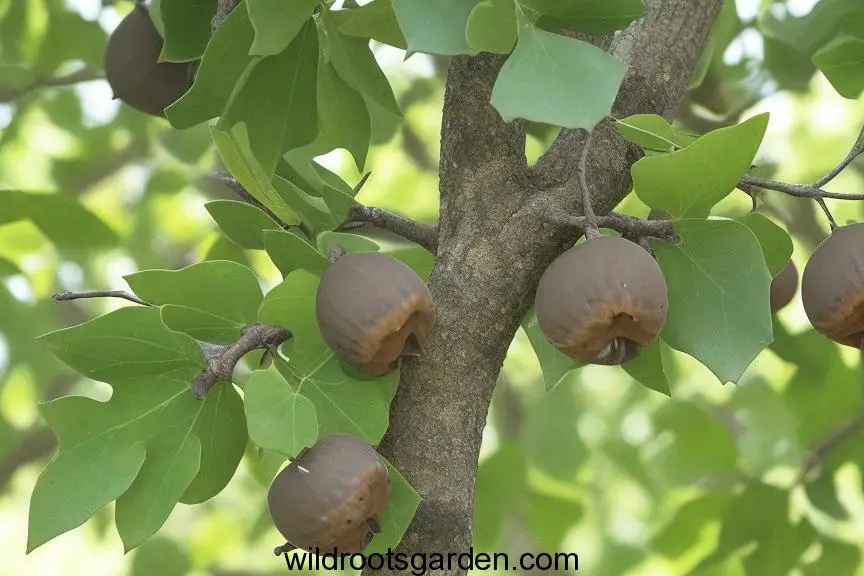
Size: The acorns of the Water Oak are relatively small, measuring around 1 to 2 cm (0.4 to 0.8 inches) in length.
Cup (Cupule): The cupule of the Water Oak acorn is shallow and saucer-like, covering a small portion of the acorn’s base, usually about one-fourth to one-third of the acorn’s length. The cupule’s edges can be smooth or slightly wavy.
Color: The color of the Water Oak acorn can vary, but it generally has a light to medium brown hue. The cupule is usually a similar color to the acorn.
Shape: The acorns are typically ovoid or oval-shaped, with a rounded tip. They have a broader base that tapers towards the top.
Oak Group: The Water Oak is part of the “red oak” group, scientifically known as Quercus sect. Lobatae. Red oaks usually have pointed lobes on their leaves, acorns that take two years to mature, and acorns that are often bitter and contain a higher tannin content compared to white oak acorns.
Please note that these descriptions provide a general idea of the characteristics of Water Oak acorns. Variations can occur due to environmental factors, location, and individual tree variability. For accurate identification, refer to a reliable field guide specific to your region or consult with local experts familiar with the native flora.
The acorn of the Oglethorpe Oak (Quercus oglethorpensis)
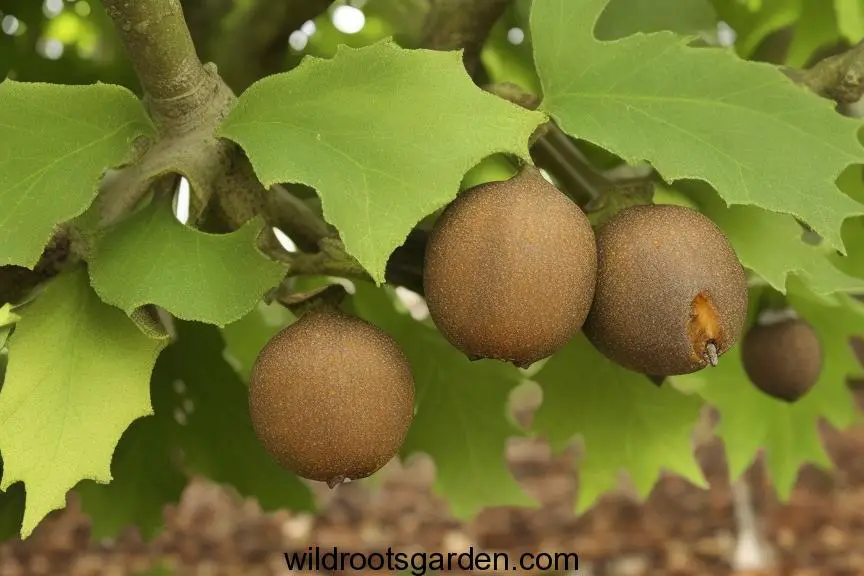
Size: The acorns of the Oglethorpe Oak are relatively small to medium in size, measuring around 1 to 2.5 cm (0.4 to 1 inch) in length.
Cup (Cupule): The cupule of the Oglethorpe Oak acorn is shallow and saucer-like, covering a small portion of the acorn’s base, usually about one-fourth to one-third of the acorn’s length. The cupule’s edges can be smooth or slightly wavy.
Color: The color of the Oglethorpe Oak acorn can vary, but it generally has a light to medium brown hue. The cupule is usually a similar color to the acorn.
Shape: The acorns are typically ovoid or oval-shaped, with a rounded tip. They have a broader base that tapers towards the top.
Oak Group: The Oglethorpe Oak is part of the “red oak” group, scientifically known as Quercus sect. Lobatae. Red oaks usually have pointed lobes on their leaves, acorns that take two years to mature, and acorns that are often bitter and contain a higher tannin content compared to white oak acorns.
Please remember that these descriptions provide a general idea of the characteristics of Oglethorpe Oak acorns. Variations can occur due to environmental factors, location, and individual tree variability. For accurate identification, refer to a reliable field guide specific to your region or consult with local experts familiar with the native flora.
The acorn of the Cherrybark Oak (Quercus pagoda)
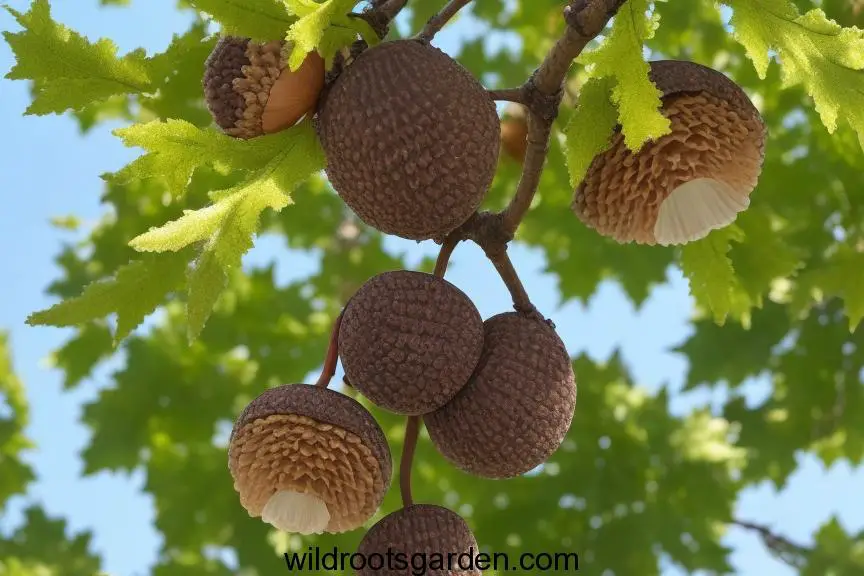
Size: The acorns of the Cherrybark Oak are relatively large, measuring around 2 to 3 cm (0.8 to 1.2 inches) in length.
Cup (Cupule): The cupule of the Cherrybark Oak acorn is shallow and saucer-like, covering a small portion of the acorn’s base, usually about one-fourth to one-third of the acorn’s length. The cupule’s edges can be smooth or slightly wavy.
Color: The color of the Cherrybark Oak acorn can vary, but it generally has a light to medium brown hue. The cupule is typically a similar color to the acorn.
Shape: The acorns are typically ovoid or oval-shaped, with a rounded tip. They have a broader base that tapers towards the top.
Oak Group: The Cherrybark Oak is part of the “red oak” group, scientifically known as Quercus sect. Lobatae. Red oaks usually have pointed lobes on their leaves, acorns that take two years to mature, and acorns that are often bitter and contain a higher tannin content compared to white oak acorns.
Please remember that these descriptions provide a general idea of the characteristics of Cherrybark Oak acorns. Variations can occur due to environmental factors, location, and individual tree variability. For accurate identification, refer to a reliable field guide specific to your region or consult with local experts familiar with the native flora.
The acorn of the Pin Oak (Quercus palustris)
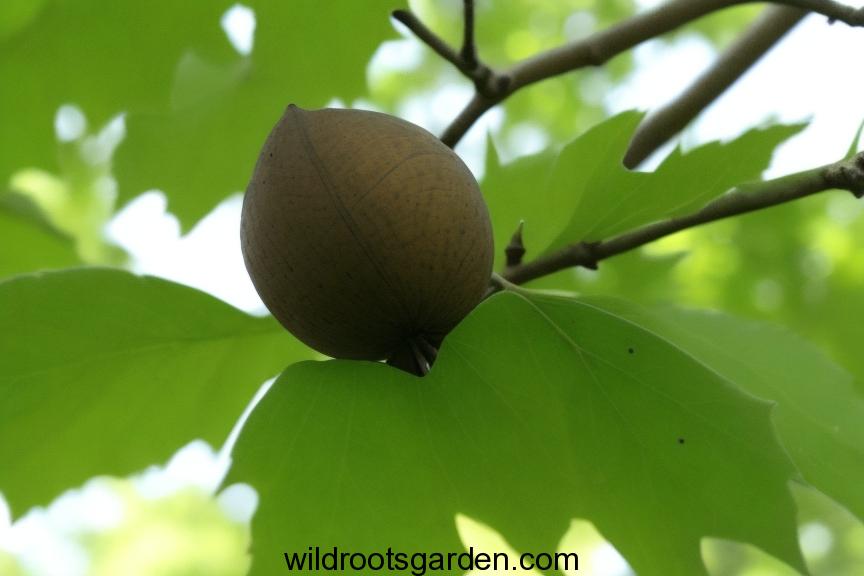
Size: The acorns of the Pin Oak are relatively small, measuring around 1 to 2 cm (0.4 to 0.8 inches) in length.
Cup (Cupule): The cupule of the Pin Oak acorn is shallow and saucer-like, covering a small portion of the acorn’s base, usually about one-fourth to one-third of the acorn’s length. The cupule’s edges can be smooth or slightly wavy.
Color: The color of the Pin Oak acorn can vary, but it generally has a light to medium brown hue. The cupule is typically a similar color to the acorn.
Shape: The acorns are typically ovoid or oval-shaped, with a rounded tip. They have a broader base that tapers towards the top.
Oak Group: The Pin Oak is part of the “red oak” group, scientifically known as Quercus sect. Lobatae. Red oaks usually have pointed lobes on their leaves, acorns that take two years to mature, and acorns that are often bitter and contain a higher tannin content compared to white oak acorns.
Please remember that these descriptions provide a general idea of the characteristics of Pin Oak acorns. Variations can occur due to environmental factors, location, and individual tree variability. For accurate identification, refer to a reliable field guide specific to your region or consult with local experts familiar with the native flora.
The acorn of the Willow Oak (Quercus phellos)
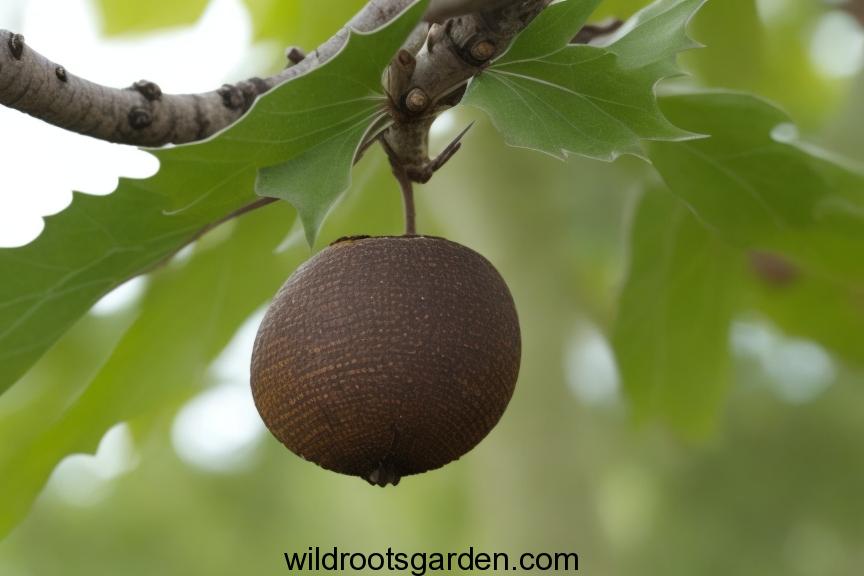
Size: The acorns of the Willow Oak are relatively small, measuring around 1 to 1.5 cm (0.4 to 0.6 inches) in length.
Cup (Cupule): The cupule of the Willow Oak acorn is shallow and saucer-like, covering a small portion of the acorn’s base, usually about one-fourth to one-third of the acorn’s length. The cupule’s edges can be smooth or slightly wavy.
Color: The color of the Willow Oak acorn can vary, but it generally has a light to medium brown hue. The cupule is typically a similar color to the acorn.
Shape: The acorns are typically ovoid or oval-shaped, with a rounded tip. They have a broader base that tapers towards the top.
Oak Group: The Willow Oak is part of the “red oak” group, scientifically known as Quercus sect. Lobatae. Red oaks usually have pointed lobes on their leaves, acorns that take two years to mature, and acorns that are often bitter and contain a higher tannin content compared to white oak acorns.
Please remember that these descriptions provide a general idea of the characteristics of Willow Oak acorns. Variations can occur due to environmental factors, location, and individual tree variability. For accurate identification, refer to a reliable field guide specific to your region or consult with local experts familiar with the native flora.
The acorn of the Dwarf Chinkapin Oak (Quercus prinoides)
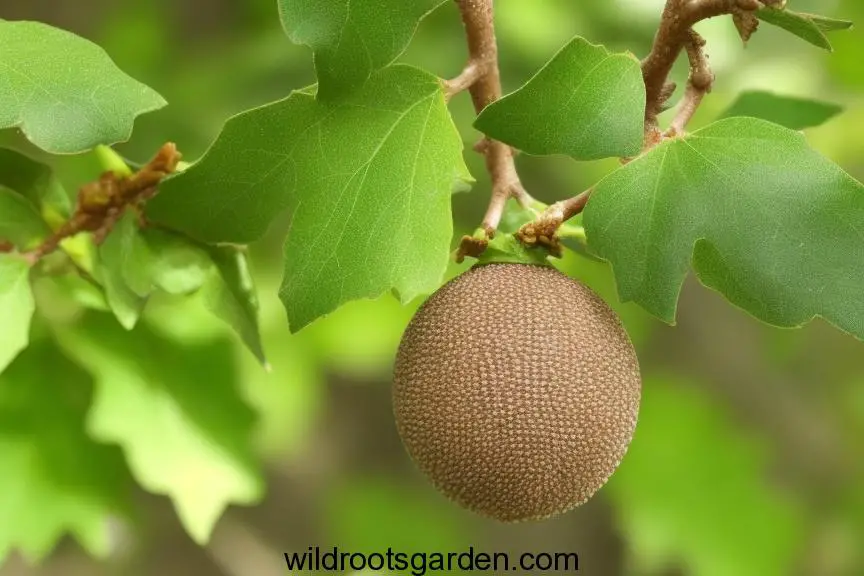
Size: The acorns of the Dwarf Chinkapin Oak are relatively small, measuring around 0.5 to 1 cm (0.2 to 0.4 inches) in length.
Cup (Cupule): The cupule of the Dwarf Chinkapin Oak acorn is shallow and saucer-like, covering a small portion of the acorn’s base, usually about one-fourth to one-third of the acorn’s length. The cupule’s edges can be smooth or slightly wavy.
Color: The color of the Dwarf Chinkapin Oak acorn can vary, but it generally has a light to medium brown hue. The cupule is typically a similar color to the acorn.
Shape: The acorns are typically ovoid or oval-shaped, with a rounded tip. They have a broader base that tapers towards the top. Dwarf Chinkapin Oak acorns are often slightly flattened.
Oak Group: The Dwarf Chinkapin Oak is part of the “white oak” group, scientifically known as Quercus sect. Quercus. White oaks usually have rounded lobes on their leaves, acorns that mature in one year, and acorns with a relatively sweet or less bitter taste compared to red oak acorns.
Please remember that these descriptions provide a general idea of the characteristics of Dwarf Chinkapin Oak acorns. Variations can occur due to environmental factors, location, and individual tree variability. For accurate identification, refer to a reliable field guide specific to your region or consult with local experts familiar with the native flora.
The acorn of the English Oak (Quercus robur)
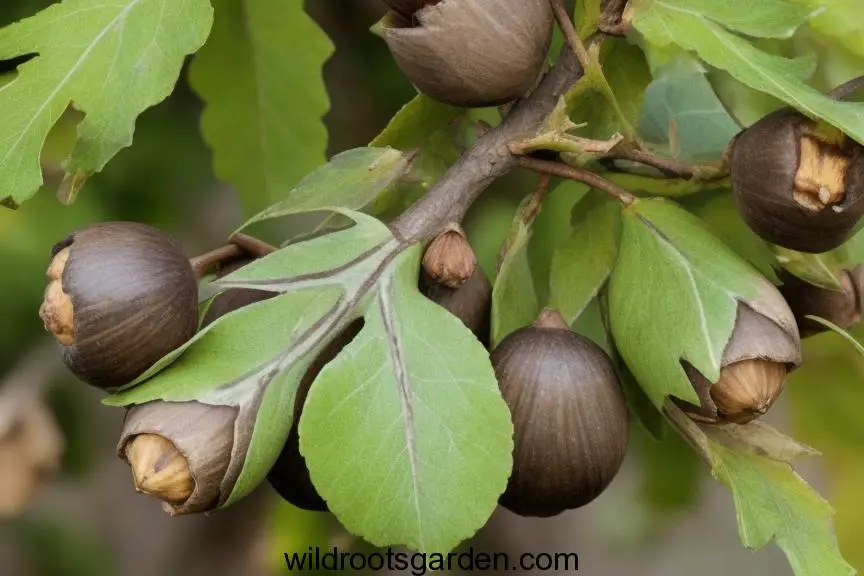
Size: The acorns of the English Oak are relatively small to medium in size, measuring around 2 to 3 cm (0.8 to 1.2 inches) in length.
Cup (Cupule): The cupule of the English Oak acorn is shallow and saucer-like, covering a small portion of the acorn’s base, usually about one-fourth to one-third of the acorn’s length. The cupule’s edges can be smooth or slightly wavy.
Color: The color of the English Oak acorn can vary, but it generally has a light to medium brown hue. The cupule is typically a similar color to the acorn.
Shape: The acorns are typically ovoid or oval-shaped, with a rounded tip. They have a broader base that tapers towards the top.
Oak Group: The English Oak is part of the “white oak” group, scientifically known as Quercus sect. Quercus. White oaks usually have rounded lobes on their leaves, acorns that mature in one year, and acorns with a relatively sweet or less bitter taste compared to red oak acorns.
Please remember that these descriptions provide a general idea of the characteristics of English Oak acorns. Variations can occur due to environmental factors, location, and individual tree variability. For accurate identification, refer to a reliable field guide specific to your region or consult with local experts familiar with the native flora.
The acorn of the Northern Red Oak (Quercus rubra)
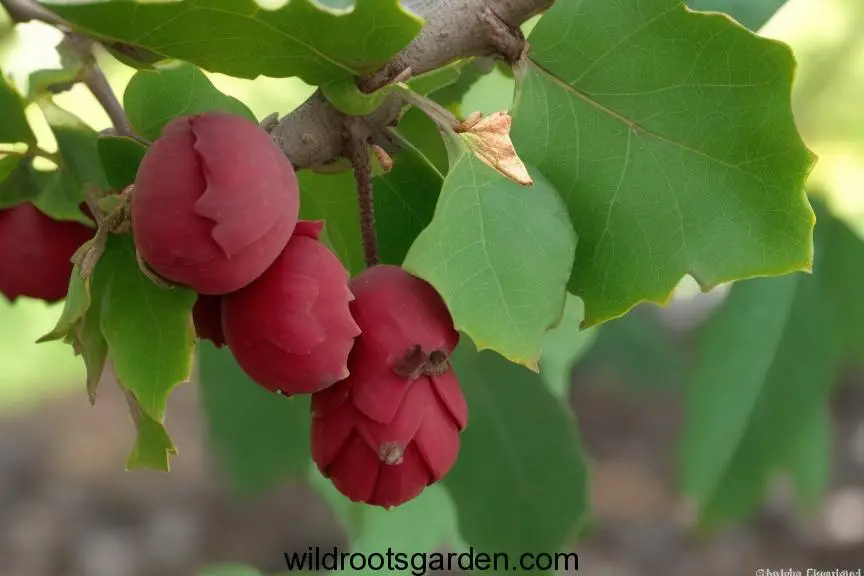
Size: The acorns of the Northern Red Oak are relatively small to medium in size, measuring around 1 to 2 cm (0.4 to 0.8 inches) in length.
Cup (Cupule): The cupule of the Northern Red Oak acorn is shallow and saucer-like, covering a small portion of the acorn’s base, usually about one-fourth to one-third of the acorn’s length. The cupule’s edges can be smooth or slightly wavy.
Color: The color of the Northern Red Oak acorn can vary, but it generally has a light to medium brown hue. The cupule is typically a similar color to the acorn.
Shape: The acorns are typically ovoid or oval-shaped, with a rounded tip. They have a broader base that tapers towards the top.
Oak Group: The Northern Red Oak is part of the “red oak” group, scientifically known as Quercus sect. Lobatae. Red oaks usually have pointed lobes on their leaves, acorns that take two years to mature, and acorns that are often bitter and contain a higher tannin content compared to white oak acorns.
Please remember that these descriptions provide a general idea of the characteristics of Northern Red Oak acorns. Variations can occur due to environmental factors, location, and individual tree variability. For accurate identification, refer to a reliable field guide specific to your region or consult with local experts familiar with the native flora.
The acorn of the Shumard Oak (Quercus shumardii)
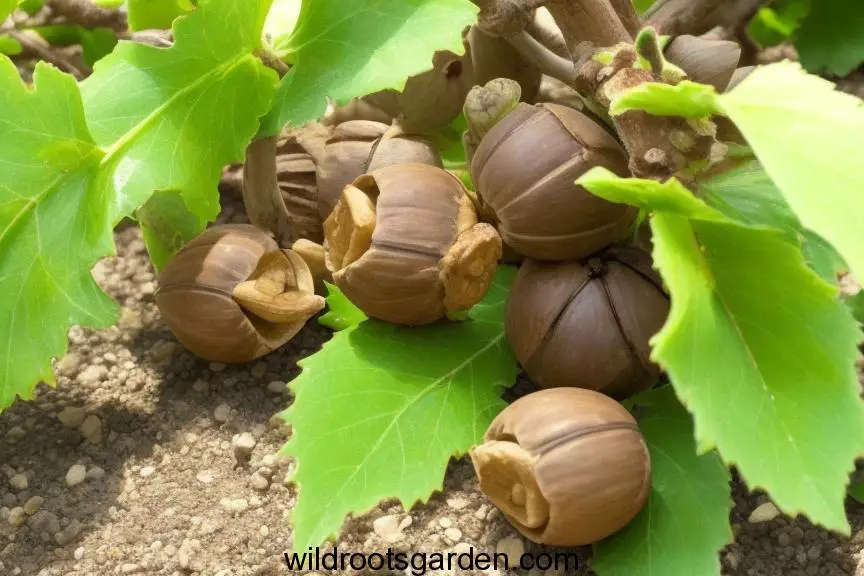
Size: The acorns of the Shumard Oak are relatively large, measuring around 2 to 4 cm (0.8 to 1.6 inches) in length.
Cup (Cupule): The cupule of the Shumard Oak acorn is shallow and saucer-like, covering a small portion of the acorn’s base, usually about one-fourth to one-third of the acorn’s length. The cupule’s edges can be smooth or slightly wavy.
Color: The color of the Shumard Oak acorn can vary, but it generally has a light to medium brown hue. The cupule is typically a similar color to the acorn.
Shape: The acorns are typically ovoid or oval-shaped, with a rounded tip. They have a broader base that tapers towards the top.
Oak Group: The Shumard Oak is part of the “red oak” group, scientifically known as Quercus sect. Lobatae. Red oaks usually have pointed lobes on their leaves, acorns that take two years to mature, and acorns that are often bitter and contain a higher tannin content compared to white oak acorns.
Please remember that these descriptions provide a general idea of the characteristics of Shumard Oak acorns. Variations can occur due to environmental factors, location, and individual tree variability. For accurate identification, refer to a reliable field guide specific to your region or consult with local experts familiar with the native flora.
The acorn of the Swamp Post Oak (Quercus similis)
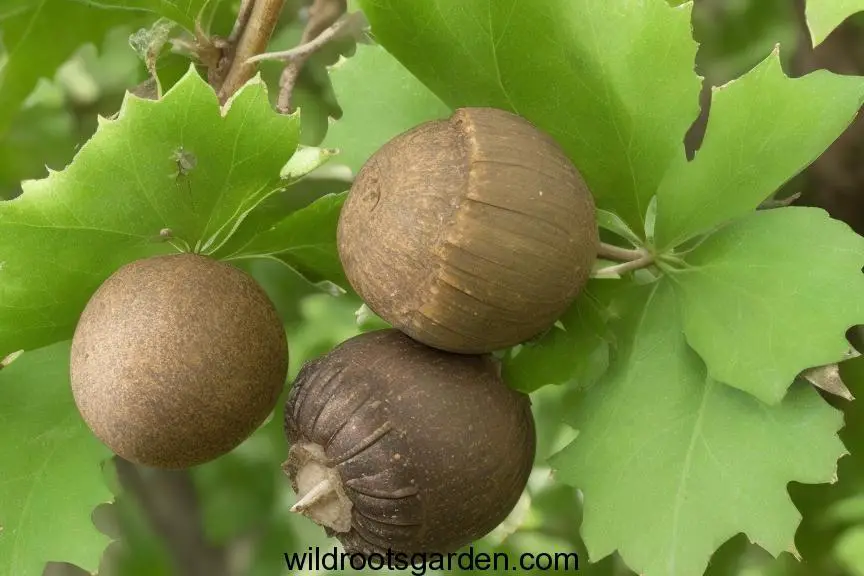
Size: The acorns of the Swamp Post Oak are relatively small to medium in size, measuring around 1 to 2 cm (0.4 to 0.8 inches) in length.
Cup (Cupule): The cupule of the Swamp Post Oak acorn is shallow and saucer-like, covering a small portion of the acorn’s base, usually about one-fourth to one-third of the acorn’s length. The cupule’s edges can be smooth or slightly wavy.
Color: The color of the Swamp Post Oak acorn can vary, but it generally has a light to medium brown hue. The cupule is typically a similar color to the acorn.
Shape: The acorns are typically ovoid or oval-shaped, with a rounded tip. They have a broader base that tapers towards the top.
Oak Group: The Swamp Post Oak is part of the “red oak” group, scientifically known as Quercus sect. Lobatae. Red oaks usually have pointed lobes on their leaves, acorns that take two years to mature, and acorns that are often bitter and contain a higher tannin content compared to white oak acorns.
Please remember that these descriptions provide a general idea of the characteristics of Swamp Post Oak acorns. Variations can occur due to environmental factors, location, and individual tree variability. For accurate identification, refer to a reliable field guide specific to your region or consult with local experts familiar with the native flora.
The Acorn of the Bastard Oak (Quercus sinuata)
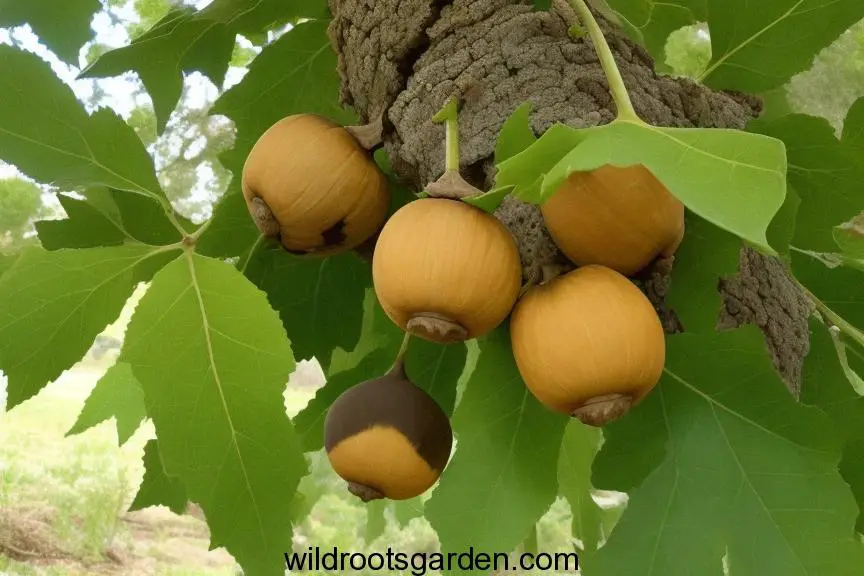
Size: The acorns of the Bastard Oak are relatively small to medium in size, measuring around 1 to 2 cm (0.4 to 0.8 inches) in length.
Cup (Cupule): The cupule of the Bastard Oak acorn is shallow and saucer-like, covering a small portion of the acorn’s base, usually about one-fourth to one-third of the acorn’s length. The cupule’s edges can be smooth or slightly wavy.
Color: The color of the Bastard Oak acorn can vary, but it generally has a light to medium brown hue. The cupule is typically a similar color to the acorn.
Shape: The acorns are typically ovoid or oval-shaped, with a rounded tip. They have a broader base that tapers towards the top.
Oak Group: The Bastard Oak is part of the “white oak” group, scientifically known as Quercus sect. Quercus. White oaks usually have rounded lobes on their leaves, acorns that mature in one year, and acorns with a relatively sweet or less bitter taste compared to red oak acorns.
Please remember that these descriptions provide a general idea of the characteristics of Bastard Oak acorns. Variations can occur due to environmental factors, location, and individual tree variability. For accurate identification, refer to a reliable field guide specific to your region or consult with local experts familiar with the native flora.
The acorn of the Post Oak (Quercus stellata)
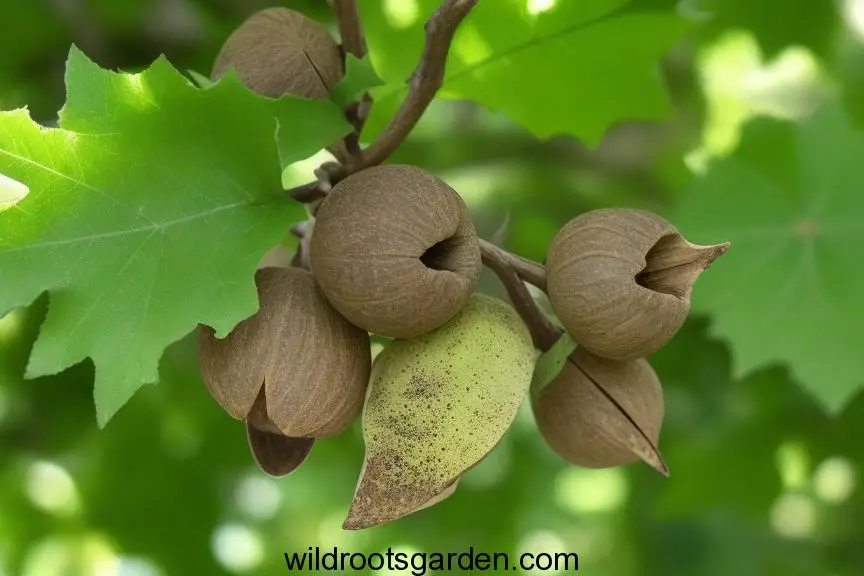
Size: The acorns of the Post Oak are relatively small to medium in size, measuring around 1 to 2.5 cm (0.4 to 1 inch) in length.
Cup (Cupule): The cupule of the Post Oak acorn is shallow and saucer-like, covering a small portion of the acorn’s base, usually about one-fourth to one-third of the acorn’s length. The cupule’s edges can be smooth or slightly wavy.
Color: The color of the Post Oak acorn can vary, but it generally has a light to medium brown hue. The cupule is typically a similar color to the acorn.
Shape: The acorns are typically ovoid or oval-shaped, with a rounded tip. They have a broader base that tapers towards the top.
Oak Group: The Post Oak is part of the “white oak” group, scientifically known as Quercus sect. Quercus. White oaks usually have rounded lobes on their leaves, acorns that mature in one year, and acorns with a relatively sweet or less bitter taste compared to red oak acorns.
Please remember that these descriptions provide a general idea of the characteristics of Post Oak acorns. Variations can occur due to environmental factors, location, and individual tree variability. For accurate identification, refer to a reliable field guide specific to your region or consult with local experts familiar with the native flora.
The acorn of the Texas Red Oak (Quercus buckleyi)
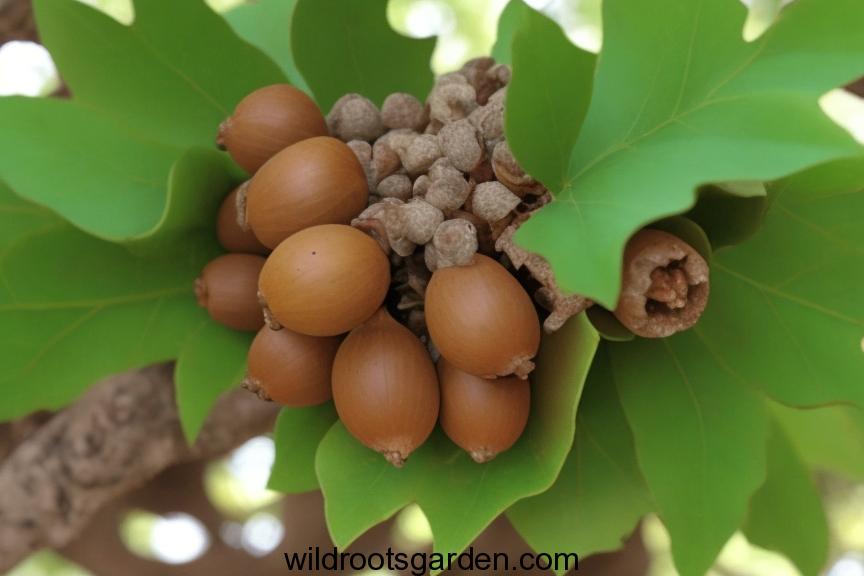
Size: The acorns of the Texas Red Oak are relatively small to medium in size, measuring around 1 to 2 cm (0.4 to 0.8 inches) in length.
Cup (Cupule): The cupule of the Texas Red Oak acorn is shallow and saucer-like, covering a small portion of the acorn’s base, usually about one-fourth to one-third of the acorn’s length. The cupule’s edges can be smooth or slightly wavy.
Color: The color of the Texas Red Oak acorn can vary, but it generally has a light to medium brown hue. The cupule is typically a similar color to the acorn.
Shape: The acorns are typically ovoid or oval-shaped, with a rounded tip. They have a broader base that tapers towards the top.
Oak Group: The Texas Red Oak is part of the “red oak” group, scientifically known as Quercus sect. Lobatae. Red oaks usually have pointed lobes on their leaves, acorns that take two years to mature, and acorns that are often bitter and contain a higher tannin content compared to white oak acorns.
Please remember that these descriptions provide a general idea of the characteristics of Texas Red Oak acorns. Variations can occur due to environmental factors, location, and individual tree variability. For accurate identification, refer to a reliable field guide specific to your region or consult with local experts familiar with the native flora.
The acorn of the Black Oak (Quercus velutina)
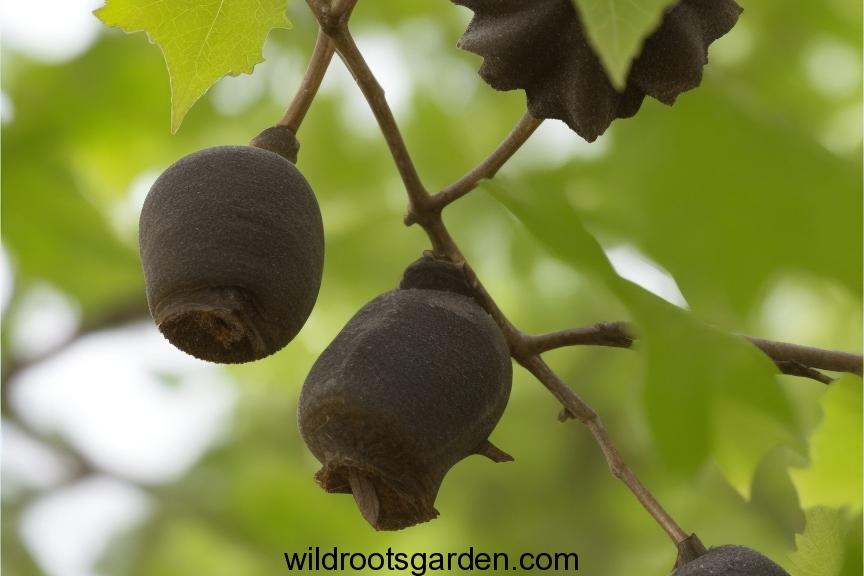
Size: The acorns of the Black Oak are relatively small to medium in size, measuring around 2 to 3 cm (0.8 to 1.2 inches) in length.
Cup (Cupule): The cupule of the Black Oak acorn is shallow and saucer-like, covering a small portion of the acorn’s base, usually about one-fourth to one-third of the acorn’s length. The cupule’s edges can be smooth or slightly wavy.
Color: The color of the Black Oak acorn can vary, but it generally has a light to medium brown hue. The cupule is typically a similar color to the acorn.
Shape: The acorns are typically ovoid or oval-shaped, with a rounded tip. They have a broader base that tapers towards the top.
Oak Group: The Black Oak is part of the “red oak” group, scientifically known as Quercus sect. Lobatae. Red oaks usually have pointed lobes on their leaves, acorns that take two years to mature, and acorns that are often bitter and contain a higher tannin content compared to white oak acorns.
Please remember that these descriptions provide a general idea of the characteristics of Black Oak acorns. Variations can occur due to environmental factors, location, and individual tree variability. For accurate identification, refer to a reliable field guide specific to your region or consult with local experts familiar with the native flora.
The acorn of the Southern Live Oak (Quercus virginiana)
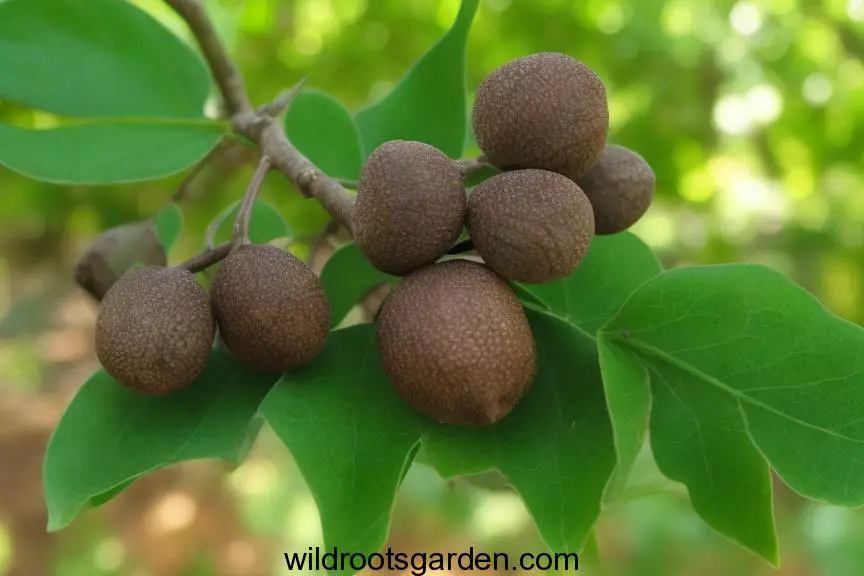
Size: The acorns of the Southern Live Oak are relatively small to medium in size, measuring around 1 to 2 cm (0.4 to 0.8 inches) in length.
Cup (Cupule): The cupule of the Southern Live Oak acorn is shallow and saucer-like, covering a small portion of the acorn’s base, usually about one-fourth to one-third of the acorn’s length. The cupule’s edges can be smooth or slightly wavy.
Color: The color of the Southern Live Oak acorn can vary, but it generally has a light to medium brown hue. The cupule is typically a similar color to the acorn.
Shape: The acorns are typically ovoid or oval-shaped, with a rounded tip. They have a broader base that tapers towards the top.
Oak Group: The Southern Live Oak is part of the “white oak” group, scientifically known as Quercus sect. Quercus. White oaks usually have rounded lobes on their leaves, acorns that mature in one year, and acorns with a relatively sweet or less bitter taste compared to red oak acorns.
Please remember that these descriptions provide a general idea of the characteristics of Southern Live Oak acorns. Variations can occur due to environmental factors, location, and individual tree variability. For accurate identification, refer to a reliable field guide specific to your region or consult with local experts familiar with the native flora.
Frequently Asked Questions
1. What is the purpose of “A Comprehensive Guide to Identifying Acorns”?
The purpose of “A Comprehensive Guide to Identifying Acorns” is to provide a detailed and user-friendly resource for individuals interested in identifying different types of acorns. This guide aims to help readers differentiate between various acorn species, understand their characteristics, and learn about the trees that produce them.
2. How can I distinguish between different types of acorns using the guide?
The guide offers a variety of visual cues and descriptions to help you differentiate between different acorn types. It includes detailed images of acorns, leaves, and the trees they come from. Additionally, the guide provides information on size, shape, color, cap appearance, and other distinctive features that can aid in accurate identification.
3. Are there any safety considerations mentioned in the guide?
Yes, the guide addresses safety considerations. It emphasizes the importance of not consuming wild acorns without proper processing, as some acorns may contain bitter or toxic compounds. The guide provides instructions on how to leach out these compounds to make acorns suitable for consumption. It also cautions readers about potential allergic reactions or sensitivities.
4. Is this guide suitable for both beginners and experts in botany?
Absolutely. “A Comprehensive Guide to Identifying Acorns” is designed to cater to a wide range of audiences. It starts with the basics for beginners, including clear explanations of terms and easy-to-understand visuals. For more advanced enthusiasts, the guide delves into finer details, scientific terminology, and subtle differences between acorn species.
5. Does the guide cover information about the ecological significance of acorns?
Yes, the guide goes beyond identification and delves into the ecological significance of acorns. It explains the role of acorns in forest ecosystems, as they provide essential food sources for various wildlife species. The guide also discusses the symbiotic relationships between acorn-producing trees and animals that help disperse their seeds, contributing to the health and diversity of forests.

